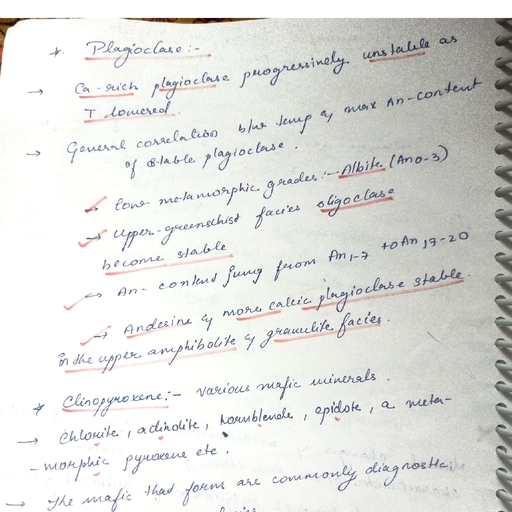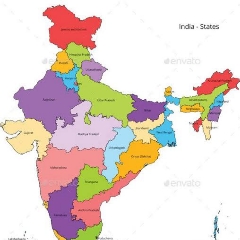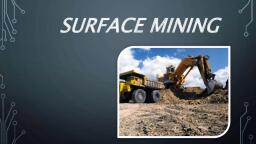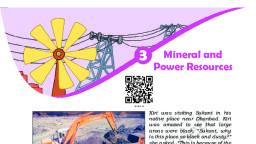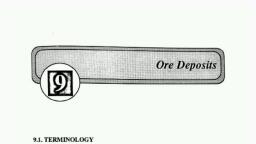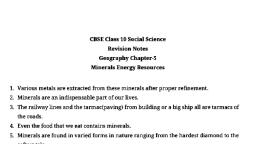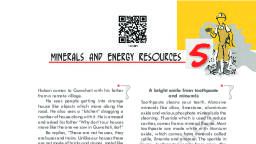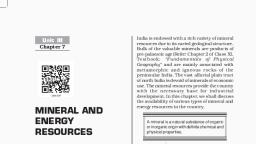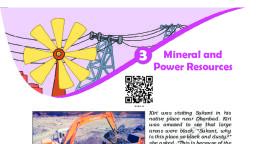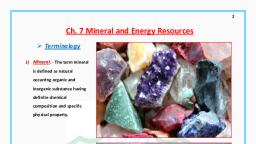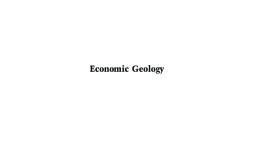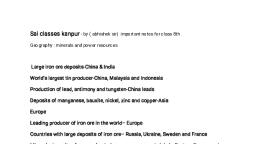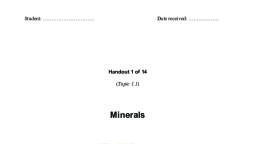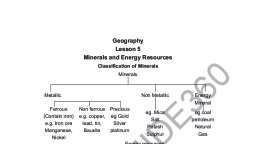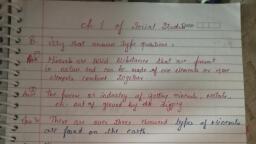Page 1 :
Economic Geology
Page 2 :
What is Economic Geology?, • Economic geology is a branch of geology that deals with economically valuable, geological or earth materials which are utilized by mankind to fulfill his needs., • Materials: Precious & Base Metals, non-metals, construction grade stones,, petroleum minerals, coal etc., • This subject provides detailed knowledge of all these minerals,, • like their origin,, • process of formation,, • mutual relations and time sequence,, • control of localization, metallogenic epoch and province,, • and classification,, • besides their mineralogy,, • uses, modes of occurrence,, • geological and geographical distribution,, • reserves, production and all other related facts.
Page 3 :
By using techniques like, ❖ Geochemistry, ❖ Mineralogy, ❖ Geophysics, ❖ Petrology, ❖ Structural Geology, Or all of these…., Therefore, “Economic Geology helps us to know HOW? WHY? & WHERE? minerals are, concentrated in specific rocks, structures & tectonic settings with the Earth’s Crust.
Page 4 :
Then what is Ore Geology??, • In ore geology we study metals only., , • But in case of economic geology we study both metals as well as non-metals., In other words, Ore Geology is a branch of Economic Geology., , What is Ore then??, A Mineral from which one or more metal mineral can be extracted profitably, (economically) is known as Ore or Ore Mineral.
Page 5 :
It’s all about Minerals…., Mineral:, • A mineral is a naturally occurring homogeneous inorganic compound which, has definite chemical composition and a fixed internal atomic arrangement., , Mineral Deposit:, A mineral deposit, or to be more particular, an economic mineral deposit may, be metalliferous or nonmetalliferous.
Page 6 :
Economic Minerals may be classified according to their use in, industry as follows:, 1. Metallic minerals: Ferrous group. They include minerals like iron, chromite, manganese, and nickel., 2. Metallic minerals: Non-ferrous group. These feature copper, lead, zinc, tungsten,, aluminum, vanadium and others., 3. Non-metallic minerals: They are mica, steatite, asbestos and others., 4. Refractory minerals: They are used as heat resistant’s in furnaces and molds. They, include chromite, magnesite, kyanite, fireclays, sillimanite and graphite., 5. Fertilizer minerals: such as gypsum, rock phosphate and pyrite., 6. Mineral fuels: such as coal, petroleum, natural gas and nuclear minerals.
Page 7 :
Ore or Ore Mineral:, • A Mineral from which one or more metal mineral can be extracted profitably, (economically) is known as Ore Mineral., • It can be high grade or low grade depending upon the percentage of the metal present, in it., , Gangue Mineral:, The useless minerals which occur in association with the ore., , Ore Deposit:, • The mixture of ore mineral and gangue mineral is known as Ore Deposit. The Ore, deposit generally found enclosed within the country rock., • The deposit has to be of considerable size and volume, often in terms of millions of, tons, to qualify as an ore deposit. Hence the definition of an ore deposit is also size, dependent.
Page 8 :
Host Rock, The rock within which the ore deposit occurs., , Country Rock, The rock which surrounds the ore deposit., , Tenor, Tenor of ore is the lowest permissible metallic deposit in an ore. Any ore must, contain some percentage of a metal in it., or, The term tenor describes the metal content of an ore. It is generally expressed in, percentage of the metal.
Page 9 :
Grade, Concentration of metal in an ore is called Grade., (Grade is subject matter of Industrial Classification), Assaying – The process of determining the concentration is called Assaying., , Cut off grade: A grade below which it is not possible to mine an ore deposit profitably, at a particular time., or, A minimum concentration which is necessary to continue a mining with profit.
Page 10 :
Syngenetic:, refers to ore deposits that form at the same time as their host rocks., , Epigenetic:, refers to ore deposits that form after their host rocks., , Hypogene:, refers to mineralization caused by ascending hydrothermal solutions., , Supergene:, refers to mineralization caused by descending solutions. Generally refers to, the enrichment processes accompanying the weathering and oxidation of, sulfide and oxide ores at or near the surface.
Page 11 :
Epithermal:, hydrothermal ore deposits formed at shallow depths (less than 1500 meters), and fairly low temperatures (50–200 °C)., , Mesothermal:, hydrothermal ore deposits formed at intermediate depths (1500–4500, meters) and temperatures (200–300 °C)., , Hypothermal:, hydrothermal ore deposits formed at substantial depths (greater than 4500, meters) and elevated temperatures (300–500 °C).
Page 12 :
Stratiform Ore:, • As the name indicates the deposit reflect stratification, i.e. in the form of, a bed or in the form of lamination., • Most of the concordant mineral deposit can be considered as stratiform., • Stratiform deposits can be sulphides, oxides and sulphates., • They can occur in sedimentary as well as in volcanic environment, , Stratabound Ore:, •, •, , As the name indicates the mineralization is restricted to a particular, lithology., In Stratabound deposits, morphology of the deposits has no, consideration and the main aspect is a stratigraphical range of the host, rock., , Note:, Hence, stratiform deposit can be a stratabound deposit, but a stratabound deposit need not necessarily, be stratiform.
Page 13 :
Metallogeny:, the study of the genesis of mineral deposits, with emphasis on its relationship, in space and time to geological features of the Earth’s crust., , Metallogenic Epoch:, a unit of geologic time favorable for the deposition of ores or characterized by, a particular assemblage of deposit types., , Metallogenic Province:, is a geographic area characterized by a particular assemblage of mineral, deposits, or by a distinctive style of mineralization.
Page 14 :
Classification of Mineral Deposits, • The purpose of any classification is to group similar objects into classes or sets either, for convenience., • By now, there are many classification schemes available for ore deposits., • Most of these classifications are based on genetic concepts prevalent at that time or, believed by the authors., • Every classification has it’s own advantages and disadvantages.
Page 15 :
Lindgren’s Classification, • Lindgren (1911) was the first in the early part of twentieth century to bring out a, detailed genetic classification of mineral deposits which he himself modified, later (Lindgren 1922) through his own experience., • It has now become the most widely adopted classification., • Lindgren (1911) classified mineral deposits in two main sub divisions :, i. those formed by mechanical concentration, and, ii. those formed by chemical reactions in solutions, • The chief basis of distinction between groups in the classification is the, temperature and pressure of formation of deposits.
Page 17 :
Objections….., 1. The classifications, divisions, and subdivisions do not themselves constitute, appropriate names by which the deposits within them may be designated;, for example, deposits of class IIA1, or “Deposits produced by chemical, processes of concentration in bodies of surface waters by interaction of, solutions,” could be more satisfactorily and briefly called sedimentary deposits,, which, except for bog iron ores, are all that are described under this grouping., 2. The terminology of class IIB2b (a), or “deposits produced by hot ascending waters, of uncertain origin, but charged with igneous emanations,” which are more, generally known as hydrothermal deposits., 3. The Lindgren classification does not apply to many zoned deposits., for example ,The Butte, Mont., deposits, are classed as mesothermal, yet the, Gagnon vein extends from the central or higher-temperature zone, through the, intermediate and into the outer or lower-temperature zone.
Page 18 :
Lindgren in 1922, recognizing the disadvantage of concise terminology in his classification,, proposed additional terminology as follows:
Page 19 :
This arrangement met with objection because it distinguished emanation deposits, formed from magmatic vapors from deposits formed from liquid solutions., Unfortunately, conclusive criteria for recognition of deposits formed by vapors are not, available., , This revision was not adopted by Lindgren in the later editions of his Mineral Deposits.
Page 21 :
Schneiderhohn’s Classification, In 1932 A more extended genetic classification was introduced.
Page 22 :
Jensen and Bateman’s (1981), classification of ore deposits, • Bateman (1942) proposed a, classification of mineral deposits, which was few decades later, modified and elaborated upon, (Jensen and Bateman 1981), • This classification is a simplified, version, of, Lindgren's,, but, subdivisions are according to, processes of deposition and form, of deposit.
Page 23 :
Conclusion…, • Formation of mineral deposits is a complex process, and most of the processes grade, into each other by changing variables of the system such as temperature, pressure,, host rock, fluid composition., • Thus the classifications of mineral deposits should be flexible, and should allow, gradations or intermediate classes., • Niggli, Schneiderhohn, Lindgren, and Bateman classifications are essentially similar;, genesis or nature of the ore-bearing fluid is the basis of the primary subdivision in all, of them., • Niggli and Schneiderhohn classifications include subdivisions for mineral associations, or metal content of the deposits. So, they may be used in the field., • Lindgren tried to place physical and chemical processes in depth temperature zones., • Bateman classification is the simplest; it emphasizes the process of formation and, the form of the deposit.
Page 24 :
Economic Geology
Page 25 :
PROCESSES OF FORMATION OF ORE DEPOSITS, The geological processes that yield mineral deposits are as follows:, • 1. Magmatic Concentration, , • 2. Sublimation, • 3. Pegmatitic Ore Deposits, • 4. Hydrothermal Processes, , • 5. Oxidation and Supergene Enrichment, • 6. Contact Metasomatism, • 7. Metamorphism, • 8. Residual and Mechanical Concentration, • 9. Sedimentation, • 10. Evaporation
Page 26 :
Magmatic Concentration, • The magmatic deposits are formed during different stages of magma crystallization., • Magmatic ore deposits are characterized by their close relationship with, intermediate or deep-seated intrusive igneous rocks., • Temperature varies in between (Formation of Deposits): 1500⁰C - 300⁰C, , • Magmatic Concentration deposits are divided into two major groups –, 1. Early Magmatic Deposits, 2. Late Magmatic Deposits
Page 28 :
Early Magmatic Deposits, • They are formed during the early stage of magmatic crystallization. In this case the, ore minerals crystallize earlier than the rock silicates., • The minerals of Ni, Cr, & Pt are usually found as early magmatic deposits., , • The Early magmatic deposits have been classified into three groups:, i., , Dissemination Deposits, , ii., , Segregation Deposits, , iii. Injection
Page 29 :
1.Dissemination Deposits:, (Dissemination Crystallization without concentration), , When a magma crystallizes under deep seated conditions, a granular igneous rock is, , formed., • In such a rock early formed, crystals of ore minerals may occur in dissemination., • Here grains of ore are found scattered more or less evenly throughout the rock, mass. Hence the whole rock mass constitutes the ore deposit., • The dissemination deposits occur in the shape of a dyke, pipe or small stock like, mass., Examples:, 1. Diamond Pipes in Kimberlite in Panna (M.P.) & in Vajrakarur village, Anantpur, district (A.P.), 2. Corundum in Syenite near Sivamalai in Tamil Nadu
Page 30 :
2. Segregation Deposits:, (Crystallization, Differentiation & Accumulation), They are formed as a result of gravitative crystallization differentiation., • In such cases, the ore minerals which crystallize early, get, Concentrated in particularly lower part of the igneous mass., , • The segregation deposits are generally lenticular in shape and of, relatively small size., , Example:, 1. Chromite Deposits of Bushveld Complex of S.A., 2. Chromite Deposits of Sukinda Ultramafic Complex, Orissa, 3. Nuggihalli & Byrapur chromite deposits in Karnataka.
Page 31 :
3. Injection, (Crystallization, differentiation and Injection), , The ore mineral is concentrated by the crystallization and, differentiation if the magmatic material is injected into the host rock., • It occurs as veins and lenses within the ultrabasic and gabbro, , Example:, 1. Magnetite vein deposits of Kiruna in Sweden., 2. Magnetite-Pyrrhotite vein deposits in Godavari district of A.P.
Page 32 :
Late Magmatic Deposits, • The ore deposits which are formed towards the close of the Magmatic period are called "Late Magmatic, Deposits "., • The late magmatic deposits contain those ore minerals which have crystallized at rather low temperature, from a residual magma., • The magma which is left after crystallization of the early formed rock silicates, is called "residual magma"., • The late magmatic deposits are always associated with mafic igneous rocks., • They have been resulted from variations of crystallization, differentiation and gravitative accumulation of, , heavy residual liquids and immiscible liquids., • The late magmatic deposits have been classified into four groups:, i., , Residual liquid segregation, , ii., , Residual liquid injection,, , iii., , Immiscible liquid segregation and, , iv., , Immiscible liquid injection.
Page 33 :
1. Residual liquid Segregation, • In this type of mafic magma, the residual magma becomes progressively enriched in iron,, titanium and volatiles., • This heavy residual liquid may segregate and crystallize within the parent igneous mass as, parallel bands and may form valuable ore deposits., • The host rocks are commonly Anorthosites, Norites and Gabbro related mafic rocks., , Example:, 1. Titaniferous magnetitic bands of Bushweld Complex of S.A, 2. Titaniferous magnetite of Hassan District, Karnataka, 3. Vanadiferrous magnetite deposits of Mayurbhanj, Orissa
Page 34 :
2.Residual Liquid Injection, • It takes place due to earth’s disturbance like igneous intrusions., • The iron rich residual liquid accumulated as a result of differentiation of mafic magma,, may get injected into the surrounding country rocks., • The ore deposits of Magnetite and Ilmenite formed in this way, are called "injection ore, deposits". Such deposits usually occur in the form of veins, dykes or sills., Example:, , 1. Apatite-magnetite, veins of Kasipatnam in Vizag district of A.P., 2. Titaniferous magnetite deposits of Nuggihalli in Karnataka.
Page 35 :
3.Immiscible Liquid Segregation, • When a mafic magma cools, the sulfide rich immiscible liquid separates out and, accumulates at the bottom of the igneous body., • This separation is similar to that of oil and water., • The immiscible liquid consists mainly of sulfides of iron, nickel and copper. Upon, , consolidation it gives rise to the "sulfide segregation deposit "., , Example:, , 1. Lead-Zinc-Copper Sulphide deposits of Hesatu-Belbathan Belt, Bihar., 2. Insizwa, S.Africa
Page 36 :
4.Immiscible Liquid Injection, • The sulfide rich immiscible liquid which separates out during the differentiation of, mafic magma, may get injected into the enclosing rock., • It is subjective to disturbance before consolidation., • On consolidation it forms the "immiscible liquid injection deposit"., , Example:, 1. Nickel deposits of Norway., 2. Nickeliferous Chalcopyrite Pockets associated with altered basic-schists of, Singhbhum-Copper belt.
Page 37 :
Sublimation Deposits, (Sublimation is the transition of a substance directly from the solid to the gas state, without passing, through the liquid state.), , • Sublimation deposits contain only those minerals which have been volatilized by heat, and subsequently redeposited in the same form at low temperature and pressure due, to sudden cooling of the vapors., , • This process involves direct transition from solid to gaseous state and vice versa without, passing through the liquid state., • It doesn’t include minerals formed by reactions of gases and vapors., • These deposits are found associated with volcanos, thermal springs and fumaroles., Example:, Sulphur Deposits of Italy and Japan., Sulphur and Borax deposit at Puga area, Ladakh
Page 38 :
Pegmatitic Deposits, • The late residual magma which is left in the last stage of crystallization,, commonly contains silica, alkalis, water, carbon dioxide and high concentrations, , of rare minerals and metals., • When this residual magma gets injected into the enclosing rocks “Pegmatite” is, formed., • They are formed at about 575⁰ C temperature and under great pressure that’s, why Pegmatites are characterized by extremely coarse-grained texture., • The coarse-grained texture develops due to slow cooling of a low viscous magma, characterized by high volatile content.
Page 39 :
• Volatiles such as OH, Fluorine, Boron and H20 promotes ion diffusion and the, development of large crystals., • Rare elements such as Li, Be Nb, Ta, Sn and U that are also not readily, , accommodated in crystallizing silicate phases end up in the volatile fraction., • Many such pegmatites form valuable mineral deposits and mostly associated with, felsic Igneous bodies such as Granitic or quartz-diorite rocks., , • Pegmatite deposits are closely associated with the veins deposits., • On the basis of their mineralogical composition pegmatites are classified as:, 1. Simple Pegmatite: It contains quartz, feldspar and mica minerals., , 2. Complex Pegmatite: It contains rare minerals in addition to the above minerals.
Page 41 :
Hydrothermal Deposits, • The epigenetic ore deposits formed by hydrothermal solutions are called "hydrothermal ore, , deposits"., • Hydrothermal Solution:, • The term hydrothermal means ‘hot water’ with possible temperature of 500⁰ - 50⁰C., , • The hot, residual watery fluids derived during the later stages of magma crystallization when, the main rock forming minerals have already been precipitated., • This fluid hot watery solution carries metals derived from an intrusive magma, is called, , "hydrothermal solution”., • The hydrothermal solution move through cracks and openings present in the rocks and deposit, their dissolved minerals there., , • Minerals which have lowest temperatures of crystallization, migrate very far away while those, having higher temperatures of crystallization, precipitate close to the parent igneous body.
Page 42 :
The deposition from hydrothermal solutions is influenced by some factors:, ❖ Chemical changes and reactions, • The reaction between mineralizing solution and wall rock gives rise to, chemical changes., • Silicate rocks would make them alkaline or more alkaline., ❖ Temperature & Pressure, • The solution in its journey loses temperature and pressure which decreases, solubility and promotes precipitation.
Page 43 :
❖ Wall Rock Alteration, • The wall-rock alteration is quite common in case of hydrothermal deposits., • The hydrothermal mineral deposits are generally accompanied by a band of, alteration of the wall rocks., • The nature of mineralizing solution like its chemical character, temperature and, pressure as well as character and kind of wall rock decide about the nature and, intensity of alteration., • Alteration include minor color changes to mineral changes and complete, recrystallization. Generally speaking higher the temperature of deposition of, mineral, higher the alteration.
Page 45 :
• Chloritization: Development of Secondary Chlorite may result from the alteration of mafic minerals that, are ready present in the country rock. Chloritization is common in the all wall rock alteration Zone of tin, deposit., • Carbonatization: The chemical sequence of carbonatization may take two different forms, i., Dolomitization of Limestone., ii. Carbonation of Silicate Rocks., • Potassic Alteration: Potassic (k-alteration) is characterized by the formation of new K-feldspar and/or, biotite, usually together., •, , Silicification: This involves an increase in the proportion of quartz or crypto-crystalline silica (i.e., cherty, or opaline silica) in the altered rock. Silicification is often a good guide to ore, e.g., the Black Hills,, Dakota., , •, , Feldspathization: When potassium or sodium metasomatism has produced new potash feldspar or, albite and is accompanied by other alteration products. Albitization is generally seen adjacent to gold, deposit., , •, , Toumalinization: This is associated with medium to high temperature deposits. The wall rock will have, strong development of tourmaline in the form of veins. e.g., many tin and some gold vein.
Page 46 :
Other alteration types…, •, , pyritization, due to the introduction of sulfur which may attack both iron oxides, and mafic minerals., , •, , hematitization, an alteration type often associated with uranium., , •, , greisenization, a frequent form of alteration along side tin-tungsten and beryllium, deposits in granitic rocks or gneisses., , •, , fenitization, which is associated with carbonatite hosted deposits., , •, , serpentinization, the allied development of talc, can occur in both ultrabasic rocks, and limestones, , •, , zeolitization is marked by the development of stilbite, natrolite, heulandite, etc.
Page 47 :
Classification of Hydrothermal Deposits, 1. Temperature of formation, 2. Mode of formation, , Temperature of formation:, On the basic of temperature of deposition, hydrothermal deposits are classified into three, , groups:, i., , Hypothermal deposits, , ii. Mesothermal deposits, , iii. Epithermal deposits., iv. Telethermal, v. Xenothermal
Page 48 :
i. Hypothermal Deposits:, • They are formed at great depths and high T (500⁰- 300⁰C), • These are the high temperature deposits which we formed close to the, , intrusive body., • The chief are minerals which are commonly found in hypothermal deposits are, arsenopyrite, wolframite, native gold and chalcopyrite.
Page 49 :
ii. Mesothermal Deposits:, • They are formed at intermediate depths and moderate T (300°-200°C), • These are the intermediate temperature deposits which are formed at some, distance outward from the intrusive igneous mass., • The chief ore minerals of mesothermal deposits are native gold, bornite,, sphalerite, galena and argentite.
Page 50 :
iii. Epithermal Deposits:, • They are formed at intermediate depths and low T (200°-100°C), • These are the low temperature deposits formed very much away from the, intrusive body., • The ore minerals which commonly occur in epithermal deposits are ruby silver,, stibnite, and cinnabar. HgS, Sb2S3
Page 51 :
iv. Telethermal Deposits:, • They are formed at shallow depths and low T (<100°C), • They are formed from hydrothermal fluids that have migrated for long distance, , from their magmatic source, so they lost most of their heat and their potential to, react chemically with the surrounding rocks., • Some geologists believe that the telethermal deposits are the products of meteoric, water., • Common minerals are Sphalerite, Galena, Chalcopyrite, Pyrite, Native Copper,, Oxides of Uranium, Vanadium and Copper.
Page 52 :
v. Xenothermal Deposits:, • They resulted from plutons intruded in shallow depths which expelled fluids of, , high T in low pressure environment, and this cause metals of the fluid to undergo, rapid cooling and hence the mineralization load of these fluids are deposited over, short distance and hence we find low and high T minerals side by side., • Characteristic minerals of this group is complex because low T mineral such as Ag, are found side by side with the high T wolframite.
Page 53 :
Mode of formation, On the basis of mode of formation, the hydrothermal deposits have been classified into, two groups:, i., , Cavity filling deposits, , ii. Replacement deposits., • Cavity filling and replacement are the two types of deposits formed due to hydrothermal, , processes., • Cavity filling is due to deposition of minerals in various types of openings, while in metasomatic, replacement or replacement deposit the earlier formed mineral is replaced by the new mineral., , • In general, replacement deposits are formed at high temperature and pressure, and cavity, filling deposits at lower temperature and pressures
Page 54 :
i. Cavity Filling Deposits:, • The precipitation of minerals from hydrothermal solutions in the cavities or the, open spaces in rock forms cavity filling deposit., • Such a deposition takes place by change of temperature and pressure of the, hydrothermal solution., • Most of the epithermal deposits are cavity filling types.
Page 55 :
Crustification:, • The mineral which precipitates first lines the walls of the cavity., • It is the characteristic feature in the cavity filling deposits in which, ore is build in the successive layers or crusts by crusts, where the, , younger crust is deposited on an older one. A filling of this type is, called "Crustification"., • Its crystals grow inward and point towards the center., • The cause of such sequence is related to the decreasing of the mineral solubility, in the solution in accordance with the decrease in T & P, where the least soluble, mineral is deposited first while the most soluble mineral is deposited last.
Page 56 :
The process of crustification are of two types:, 1. Symmetrical, 2. Asymmetrical, Symmetrical, • A vein crustification is said to be "symmetrical" when, similar mineral crusts occur on both sides of the fissure., , Asymmetrical, • When unlike layers are present on each side, the, , crustification is called "asymmetrical".
Page 57 :
Comb Structure:, • In a mineral vein prominent crystal project inward from the walls, it is said to have, "comb structure", Vugs:, • When a vein is not filled completely with the mineral matter, open spaces are left in, the center. Such unfilled spaces are called "vugs“, Horses:, • The masses of country rock which is enclosed within the fissure veins., , Massive Ore:, • It the cavity filling deposits are composed of one mineral and devoid of, crustification, they are said to be Massive Ore., , Ribbon structure:, • Fissure fillings, composed of alternate structure of quarts and altered country rock, give rise to a characteristics structure known as Ribbon Structure.
Page 58 :
The common types of cavity filling in deposits are:, a. Fissure veins:, b. Shear zone deposits, c. Stockworks, d. Saddle reefs, e. Ladder veins, f. Pitches and Flats, g. Breccia filling deposits, h. Solution Cavity deposits, i. Pore Space filling, j. Vesicular filling
Page 59 :
Fissure veins:, • A fissure filled with ore is called "fissure vein"., , • It is a tabular ore body which occupies one or more fissures within a rock., • Fissure vein deposits are the most important of all the cavity filling deposits., • They are the chief source of most of the metals like gold, silver, copper, lead, zine and mercury., The common types of fissure veins are as follows., i., , En echelon Fissure: They appear as sets of short, parallel, planar, mineral-filled lenses within a body of a, rock. They originate as tension fractures that are parallel to the major stress orientation (σ1), in a shear, zone., , ii. Chambered Veins: Veins whose walls are irregular and brecciated., iii. Dilation or Lenticular Veins: Several disconnected lenses of ore occur together., iv. Sheeted Veins: A group of closely spaced parallel veins., , v. Linked Veins: A wide zone of nearly parallel fissures connected by diagonals.
Page 61 :
Shear zone deposits, • The shear zones are the zones of thin and closely spaced parallel fractures., • Here as the openings are minute, the open space deposition is minor., Example: Singhbhum Shear Zone Deposit, Khetri., , Stockworks, • A "Stockwork" is a mass of rock traversed by a network of small ore bearing, veins. Each vein is about one centimeter in width and a few meters in length., • Stockworks are formed when the hydrothermal solutions percolate through, vertical zones of intense shattering which occur in certain igneous intrusions., , • The spacing between the adjacent veins varies from a few centimeters to a, few meters. In stock works the whole rock mass in mined., Example: Zawar Area, Rajasthan
Page 62 :
Saddle reefs, • During folding openings are formed between rock beds at the crests of, , anticlines., • Mineralization along such opening leads to the development of ore deposits., Example: Quartz reefs of Hutti Gold deposit, Karnataka and Wyand Gold, , deposit of Tamil Nadu, , Ladder Veins, • Ladder veins are commonly found in dykes. They are the short, transverse,, roughly parallel fractures that are filled with the ore. Because they appear, like a ladder, they are called Ladder Veins., Example: Magnesite deposit of Mysore, Karnataka and Asbestos deposit of, , Cuddapah district, Andhra Pradesh
Page 64 :
Solution cavity filling, • Certain solution forming rocks like limestone gives rise to this type of deposi0t. They occur most, commonly at shallow depth. They are grouped as caves, galleries and gash veins., • Caves are characteristics of limestone regions, , • Galleries are horizontal or gently inclined waves which result from solution along fissures., • Gash veins designate vertical solution joints in limestone., Example: barytes deposits in Krol limestone of Sirmur district, Himachal Pradesh., , Pore-space filling, • Many mineral deposits occur as pore space fillings, say in sandstone. Oil, gas and water are the, most important among all., , Example: Disseminated lead-zinc deposit in gritty conglomeratic dolomite and quartzite of Zawar,, Rajasthan is an example of pore space filling..
Page 65 :
Vesicular Fillings, • The vesicular lava flows being permeable, form channel ways for mineralising solution and sites, of mineral deposits., Example: Copper occurrences in Dras volcanics, Kargil area,, Jammu and Kashmir and in Deccan trap of Maharashtra and Gujarat, Agate, chalcedony, amethyst and opal occurrences in the Deccan trap
Page 66 :
ii. Replacement Deposits:, • These deposits are formed due to chemical interaction between the hydrothermal, , solution and the country rocks., • Replacement occur through the action of hot vapor or hydrothermal solution., • The ore minerals are deposited from a mineral bearing solution in place of the, , country rocks, the replaced substances being dissolved and removed in solution., • The rate of replacement is dependent upon the rate of supply of new material and, removal of dissolved material. If the supply of material for the new mineral stops,, , other minerals may be deposited at its margins.
Page 67 :
Types of Replacement Deposits, The ore deposits formed by replacement can he subdivided into three groups:, i., , Massive deposits, , ii. Replacement lodes, iii. Disseminated deposits.
Page 68 :
i. Massive Deposits:, • The massive deposits are characterized by great variations in size and extremely, irregular form., • The ore terminates abruptly against the host rock., , • The host rock is almost completely replaced and the ore shows abrupt ending, against the country rock. The ore may retain original texture and structure of the, rocks it replaces., • Massive replacement ore deposits commonly occur in limestones., Example: Pyrite replacement deposit of Spain.
Page 69 :
ii. Replacement Lode Deposits:, • The, , lode, , deposits, , are, , formed, , when, , the, , replacement is localized along thin beds or, fissures., • In this case the fissure walls are replaced by the, ore., • The lode deposits resemble fissure veins in form;, however, they are wider than fissure veins and, their walls are wavy and irregular., Example: Gold veins of Ontario
Page 70 :
iii. Disseminated Replacement Deposits:, • The ore mineral occurs as small grains accompanied by small veinlets in the, , host rock and represents multiple center type of replacement, • These are low grade ore deposits where grains of ore minerals are found, scattered throughout the host rock., • The size of disseminated ore deposits is generally large., Example: Porphyry Copper deposit
Page 71 :
Criteria For The Recognition Of Replacement Deposits, i. Absence of crustification., ii. Presence of an unsupport cement of the country rock which remain enclosed, within the replacing mineral., iii. Existence of well developed crystals of the replaced minerals., , iv. Presence of pseudomorphs of replacing minerals after replaced ones., v. Preservation of structural features of th; replaced country rocks., vi. Occurrence of irregular veins of replacing minerals across the grains of the, , host materials.
Page 72 :
Control of Ore Localization, The ore localization is controlled by the following factors :, (i) Chemical and physical characters of host rock :, • This determines the location, shape and size of opening. For example carbonate rocks permit, solution openings and brittle rocks shatter more readily to localize fractures or breccias., • Permeability which is necessary in rock for passage of solution and ore localization, is caused, due to pore spaces, fissibility, cleavage planes/brecciation, joints, fractures etc., (ii) Structural features :, , • Structural features like fissures, shears, folds, faults, bedding planes, lamination and, unconformity serve important localizers of hydrothermal deposits., (iii) Intrusive:, • Intrusive being source of ore-bearing fluid, constitute ore loci on a regional scale.
Page 73 :
Oxidation & Supergene Enrichment, Ore Deposits:, , Definition:, It’s an upgrading of primary (inferior) ore, deposit into highly enriched economically, valuable ore deposits.
Page 74 :
Process, • If an ore deposit is exposed to the ground surface, it undergoes weathering., • The surface water oxidizes and dissolves the ore minerals from the weathered zone and carries, them downward., , • As the cold, dilute, leaching solutions trickle downwards, they may lose a part or all of their, metallic content within the zone of oxidation to give rise to oxidized ore deposits above the, water table. ., • If they penetrate the water table, their metallic content may be precipitated in form of, secondary sulfides – zone of secondary or supergene sulfide enrichment., • In this way a low-grade primary ore deposit may be enriched to form a valuable ore deposit, , • The lower, unaffected part of the deposit is called Primary or Hypogene deposit.
Page 75 :
The zones have been recognized in the oxidation & supergene enrichment deposits:, i., , Gossan:, • It is the cap-rock of an ore deposit., • A "gossan" is a ferruginous and porous looking residue that forms a superficial, cover over an oxidized sulfide deposit., , • The porous nature of gossans is caused by the removal of the soluble materials., Thus may be used as clues to the existence of subsurface ore deposits, ii. Leached Zone:, , • The groundwater contains dissolved oxygen and carbon dioxide, and as it travels, downwards it leaches out the minerals in the rocks to forms sulfuric acid, and, other solutions that continue moving downwards.
Page 76 :
iv. Oxidized Zone:, • The region above the water table in an ore deposit is known as oxidized zone as it is, the zone of oxidation of the primary ore minerals., , v. Water Table:, • At the water table the environment changes from an oxidizing environment to, a reducing one., , vi. Enriched Zone or Supergene Enrichment Zone:, • This zone lies below the water table., • It is the richest, , part of an ore deposit where metals are deposited by fluid, , percolating downwards from oxidized zone and concentrating in a narrow reducing, band just below the water table., vii. Primary Zone: The primary zone contains unaltered primary minerals.
Page 77 :
Oxidation and solution in the zone of oxidation, • The oxidation by the surface water containing dissolved oxygen causes alteration of minerals,, obliteration of structure and leaching of metallic substances., • Most metallic minerals contain pyrite, which yield in sulfur to form iron sulfate and sulfuric acid:, , 2FeS2 + 2H20 + 702 → 2H2SO4 + 2FeSO4, • The ferrous sulphate readily oxidizes to ferric sulphate and ferric hydroxide., , 6FeSO4 + 30 + 3H2O → 2Fe2 (SO4)3 + 2Fe (0H)3, • The ferric sulphate hydrolyzes to ferric hydroxide and sulfuric acid:, , Fe2(SO4)3 + 6H2O → 2Fe(OH)3 + 3H2SO4, • The ferric sulfate and sulfuric acid act as solvent for the ore minerals., , • They both attacks pyrite and other sulfides to yield more ferrous sulfate:, , Fe2(SO4)3 + FeS2 → 3FeSO4 + 2S
Page 79 :
Deposition in the zone of oxidation, • The cold dilute solution of secondary sulfates moves slowly downward. It may react with Chloride, and carbonate solutions and thus, cause deposition of chloride and carbonates of metal within the, the zone of oxidation. The ore deposits are called "oxidized ore deposits"., • When the oxidized zone is well developed and the secondary minerals sufficiently concentrated, it, is a highly profitable zone to mine as the processing is much cheaper and easier and the metals, more concentrated., , • The most common minerals found in oxidized zones are:, Copper: malachite, azurite, chrysocolla, Gangue minerals: quartz (usually cryptocrystalline), baryte, calcite, aragonite, Iron: goethite, hematite, Lead: anglesite, cerussite, Manganese: pyrolusite, romanechite, rhodochrosite, Nickel: gaspeite, garnierite, Silver: native silver, chlorargyrite, Zinc: smithsonite
Page 80 :
Deposits in the zone of supergene enrichment, • The ore minerals in solution which are not precipitated in the zone of oxidation, trickle, down below the water table, here all the pores of rocks are saturated with water, therefore no air is available for oxidation where they are deposited as secondary, sulfides., • This deposition of secondary sulfide minerals occur as a result of reaction between the, primary sulphides and the percolating solution of the metallic sulphates. The ore, deposit formed in this way is called "supergene sulfide deposit"., • In the supergene zone metals are concentrated in a narrow band just below the water, table., • Below this zone is the primary or hypogene zone which remains altogether unaffected.
Page 82 :
Contact Metasomatism, • The contact effects of escaping high-temperature gaseous emanations, , of intrusive magmas., • These effects have been divided by Barrell into two types:, i., , The effects of heat, without appreciable accessions, , ii., , The effects of heat combined with accessions from the magma chamber, , • Contact metasomatism is a process of formation of new mineral by, reaction between the contact rock and the escaping high temperature, , gaseous emanations with other important materials from the magma, chamber.
Page 83 :
How it is different from Contact Metamorphism??, • In Contact metasomatism important accessions from the magma are, , involved, leads to metasomatic reaction with the contact rocks and, forms new minerals under conditions of high temperature and, pressure., • In Contact Metamorphism there is no accessions from the magma,, only the effect of heat.
Page 84 :
• In Contact Metasomatism the magmatic emanations are highly charged with the, constituents of mineral deposits, in such cases result from accession (large volume of, material may be added and subtracted from the invaded rocks from the magma) it leads, , to the formation of contact metasomatic deposits., • All magmas do not give rise to contact metasomatic deposits., • Mostly felsic intrusive of intermediate composition. such as monzonites and, , granodiorites yield ore deposits., • The resulting mineralogy is thus more varied and complex than that by contact, metamorphism alone., • The temperature for contact metasomatism may possibly be ranging from 400° to 800°C,, or even higher.
Page 85 :
Conditions for the formation of contact metasomatic deposits:, 1., , Composition:, • Mostly felsic intrusive of intermediate composition. such as monzonites and granodiorites yield, , ore deposits., • Usually basic and ultra basic rocks are not suitable, since the felsic material has higher contact of, fluid (water) than the mafic magma, so they are best suitable., , 2., , Size and form of the intrusive:, • The intrusive must be of considerable size., • Most contact metasomatic deposits are associated with stocks, batholith etc., , 3., , Depth of intrusion:, • Most of the deposits has probably crystallized at a depth >5000 feet’s., • Contact metasomatic deposits are found only with granular groundmass, which indicates, relatively slow cooling.
Page 86 :
4., , Relation to composition:, , • The invaded rocks must be reactive., • Carbonate rocks are most effected by intrusive magmas., • Sandstone are also affected but little affected., , Resulted Mineral Deposit:, 1., , Position: Ore bodies occur at the contact or near the Intrusive., , 2., , Form & Size: Contact metasomatic deposits are generally irregular in outline & comparatively in, small size., , 3., , Texture: The ores are coarse in texture, containing large crystals. Crustification and bandings are, , absent., , Example: Deposits of Cassiterite, Zinc, Magnetite, Graphite and Sulfides of Galena, Iron, Lead etc.
Page 87 :
Metamorphism, • The word "Metamorphism" comes from the Greek: meta = after, morph = form, so, metamorphism means “change in the form”, , • The Metamorphism is an important process to give rise to many new mineral deposits, by altering the earlier deposits/rocks when subjecting a rock to conditions such, pressures, temperatures, and chemical environments different from those under which, , the rock originally formed., • It is by recrystallization and reconstitution of pre-existing rock forming minerals that, some valuable mineral deposits are formed.
Page 88 :
• The degree to which a parent rock changes during metamorphism is called its, metamorphic grade., , • Valuable nonmetallic mineral deposits are formed from rocks chiefly by, recrystallization and recombination of the rock-making minerals., There are three principle types of metamorphism namely., , 1) Contact metamorphism, 2) Dynamic metamorphism, 3) Regional metamorphism
Page 89 :
1. Contact metamorphism, • In the case of contact metamorphism the effect is nearly, to the contact of igneous intrusion and away from the, intrusion, the temperature gets reduced., • It means the main agent of metamorphism in this type is, temperature or heat, it is also called thermal, metamorphism., • This type may change the mineralogy without the, development of secondary structure like schistosity and, foliation.
Page 90 :
2. Dynamic metamorphism, • Dynamic metamorphism occurs as a result of mechanical deformation, like when, two bodies of rock slide past one another along a fault zone., • This is restricted to narrow zones like major Faults and thrust where strong, deformation has occurred., • This is accompanied by high strain and range of PT condition.
Page 91 :
3. Regional metamorphism, • This develops over a large area., • Regional metamorphism is associated with convergent margins & orogenic, activities., • Regional metamorphism produces some of the most common metamorphic, rocks., • In this process, shale is metamorphosed to produce the sequences of slate, phyllite,, schist, and gneiss., • In addition, sandstone and limestone are metamorphosed into quartzite and marble.
Page 92 :
Examples, 1., , Graphite is a product of regional or contact metamorphism., , 2., , Talc–Steatite–Soapstone is metamorphic product of magnesian-rich minerals in a rock aided by, dynamic metamorphism., , 3., , Andalusite-sillimanite-kyanite deposits are formed due to regional metamorphism of aluminous, silicate rocks., , 4., , Wollastonite comes from contact metamorphosed impure limestones., , 5., , Garnets are formed by contact metamorphism in calcareous rocks.
Page 93 :
Residual & Mechanical Concentration, Residual Concentration Deposits, • Residual ore deposits indicate the concentration of ores as residue., • During weathering the rocks undergo mechanical disintegration & chemical decay, (usually both)., • Mechanical disintegration like frost action, expansion or contraction free the rock, , sediments for chemical decay by reducing the particle size., • The minerals that are unstable under weathering conditions suffer chemical decay; the, soluble parts may be removed and the insoluble residues may accumulate, and forms, , residual concentration deposits.
Page 94 :
The conditions necessary for the formation of residual mineral deposits are, as follows., i., , The rock undergoing weathering must contain some valuable minerals., , ii., , The valuable minerals must be resistant to chemical weathering., , iii. Climatic condition must favor chemical decay i.e. tropical and sub-tropical, climate., iv. The outcrop surface should have low relief so that gravity and running water, cannot remove insoluble (residue) product., Examples: Bauxite, Iron, Manganese, Nickel, Clay, Ochre, Tin, Kyanite, Baryte etc.
Page 95 :
Mechanical Concentration Deposits, • The natural separation of heavy minerals from light ones by means of involving, , water, air or gravity, is called "mechanical concentration"., • The mineral deposits formed by this process are called "placers"., • The process of mechanical concentration takes place in two stages., , 1. Weathering of the parent rock releasing the stable minerals from the rock., 2. Concentration of the stable minerals.
Page 96 :
Concentration Of Stable Economic Minerals:• Concentration takes place only when the economic minerals have important, characters such as, i., , High specific gravity, , ii. Chemical resistance of weathering, iii. Durability., iv. Hardness
Page 97 :
The process of mechanical concentration may be summarized as follows., i., , The ore minerals are released from the rock by weathering and disintegration., , ii. The disintegrated materials are carried downslope by water, air, etc. Ultimately, this material reaches the stream or sea shore., iii. In the moving water or air, the heavier placer minerals sink to the bottom, while the lighter material is carried further. Thus, the heavier minerals are, separated from the lighter ones., iv. In this way the heavy minerals get concentrated in particular localities to form, placer deposits.
Page 98 :
The conditions necessary for the formation of a placer deposit are:, i., , There must be a primary source, such as an ore deposit, a dissemination deposit,, , or a low-grade deposit which supplies ore minerals., ii. It must be exposed to weathering on a slope from where the disintegrated, material may be carried away by water, air, gravity., , iii. The ore mineral in the deposit must be of such chemical composition that, chemically resistant to weathering., iv. For a mineral to be concentrated as a placer deposit, it must have a higher, , density than the worthless material with which it occurs.
Page 99 :
Types of Placer Deposits: The placer deposits have been divided into four groups:, i., , Eluvial placers:, •, , The eluvial placer deposits occur along the hill slopes., , •, , Here the mineral concentration is caused by gravity. When the debris produced due to, weathering of rocks, moves downslope, the heavier particles move more slowly than Lighter, , ones., •, , In this way heavier minerals get concentrated to form an eluvial placer deposit., , •, , The weathered products are washed by rain and wind. This result in the partial concentration of, placers., , Example: Gold, Tin.
Page 100 :
ii. Stream placers:, • These occur at various places along the stream., , • Here the mineral concentration is caused by running water, the weathered rock material travels with, stream water., • The concentration of heavier minerals occurs in those places where the velocity of water slackens., Place of Accumulation:, , i., , At Meanders, , ii., , Behind the riffles, , iii., , Deposition of placer minerals take place at the, , confluence, where a tributary meets the main, river., Example:, • Gold placer deposits of Subarnarekha in Bihar, • Kollur in Guntur district of Andhra Pradesh, • Pariatala diamond placer deposit in Krishna district of, Andhra Pradesh.
Page 101 :
iii. Beach placers:, • These deposits occur along sea shores where mineral concentration is caused by wave action, (or) shore action, shore current etc., • The lighter materials move faster and farther than the heavy materials., • The mineral are concentrated on the exposed beaches., • Beach sand of Kerala contain important deposits od monazite and ilmenite., Example: ilmenite, Monazite, Zircon etc. of Chabara, Kerala beach, Zircon placers along Manavala Kuruchi Near Kanyakumari, , iv. Aeolian placers:, • These placer deposits are formed wind., • They occur only in arid regions. The lighter particles are blown away form the weathered zone, by wind and concentrate patches of heavy minerals., Example: Placer Gold deposits of Australian desert.
Page 102 :
Sedimentation Deposits, • The natural processes of sedimentation, which lead to the formation of, mechanical, chemical and organic sediments a leading role in the development, of deposits of rocks and mineral of economic importance., , • The processes of formation of deposits of this type are exactly the same as, those leading to the development of common sedimentary rock, • The constituents of such deposits are removed in suspension or in solution, , from suitable parent rocks, transported to variable distance and deposited in, the form of bed, lenses or irregular bodies, where conditions favorable for their, precipitation and/or deposition.
Page 103 :
Process of deposition:, i., , During weathering, the materials are released from the source rock. In this, process the valuable mineral constituents are taken into solution. The chief, , solvents are carbonated water, organic acids and sulfate solutions., ii. Most of the valuable substances are transported either in suspension or in, solution by means of river water to the sea., iii. In the sea, the valuable material is deposited mechanically, chemically or, biochemically., iv. The chemical precipitation of materials in solution is controlled largely by the pH, and Eh of the environment. The pH is responsible for the acidic or alkaline, conditions and the Eh for the oxidation-reduction potential.
Page 104 :
Source Material, •, , The materials have been derived mainly from the weathering of rocks and oxidation of former, mineral deposits such as Fe, Mn and Cu., , Solution and Transportation:, • Solution of the constituents of economic sedimentary deposits in large part goes on during the, weathering., • The chief solvents are carbonated water, humic and other organic acids and sulphate solutions., , Deposition:, • The deposition may take place mechanically, chemically or biochemically .The manner and resulting, , products of deposition depends upon:, i., , The nature of the solvent and the place of deposition., , ii., , The type of basin of deposition., , iii., , Agency of deposition.
Page 105 :
Examples:, • Deposits of iron, manganese, copper, uranium and vanadium ores and of sulphur, limestone,, dolomite, magnesite, coal, clays, etc, , • Important Indian Deposit, i., , Iron ore deposits of Bailadila in Chhattisgarh ., , ii., , Iron Deposits of Donimalai in Karnataka., , iii., , Iron Deposits of Salem in Tamil Nadu.
Page 106 :
Evaporation Deposits, • Evaporation has been important in producing many valuable types of, nonmetallic mineral deposits., • Great sections of the oceans may be cut off during slow oscillations of land and, sea and be gradually evaporated to yield deposits of gypsum, common salt and, potash., , • Ground waters reaching arid surfaces leave behind valuable minerals upon, evaporation., • Lakes may disappear under arid conditions to form playas.
Page 107 :
Process of evaporation, 1. The main source of the evaporation deposits is sea water., 2. When a body of sea water is cutoff during oscillations of land and sea its, , water evaporate. This leads to the concentration of soluble salts., 3. When supersaturation of a salt is reached, that salt is precipitated and thus, evaporation deposits are formed., , 4. This evaporation deposits are mostly formed in warm arid climates where, evaporation proceeds very rapidly.
Page 108 :
Conditions:, • Evaporation proceeds most rapidly in warm humid climates., • Evaporation of bodies of saline water leads to concentration of soluble salts, and, when supersaturation is reached, the salts are precipitated., • Deposition of minerals by evaporation depends on supersaturation, which in turn, depends upon other factors, chief of which are:, i., , temperature, , ii. pressure, , iii. depositional environment, iv. seasonal & climatic changes
Page 109 :
• Sea water is the prime source of minerals formed by evaporation., , • About 3.45% of which consists of dissolved salts of which 99.7% by wt. is made up of, only seven ions:, •, •, •, •, •, •, •, , Na+ (30.61),, Mg2+ (3.69),, Ca2+ (1.16),, K+ (1.10),, Cl- (55.04),, SO42- (7.68), HCO3- (0.41), , • About 45 other elements whose concentration is known in sea water occur as trace, minerals in evaporites., • Few carbonates occur in marine evaporites as compared to terrestrial evaporites., Calcite, dolomite and magnesite are the chief carbonates of marine evaporites.
Page 110 :
Examples:, • The chief minerals which occur as evaporation deposits are common salt, gypsum,, , and other salts of K, Na, Ca, and Mg., • Indian Examples:, i., , Gypsum deposits of salt range in Punjab, , ii. Gypsum deposits of Trichy dt of Tamil Nadu., iii. Gypsum deposits of Bikaner, Barmer, Jaisalmer etc in Rajasthan., iv. Gypsum deposits of Porbandar and Kutch in Gujarat.
Page 111 :
COAL
Page 112 :
Coal, • It is an organic sedimentary rock that forms from the accumulation and, , preservation of plant materials, usually in a swamp environment., • The scientific definition of coal is “Coal is a solid stratified rock composed mainly of, hydrocarbons and capable of being used as a fuel to supply heat or light or both”., , • Coal is one of the chief ‘fossil fuels’ or ‘mineral fuels’. It is an important source of, heat and energy., • To be a “coal” its carbon content should be >50%.
Page 113 :
Origin of Coal, • Two theories have been put forward to explain the origin of coal seams., 1. Insitu theory, 2. Drift theory.
Page 114 :
Insitu theory:, • The Insitu theory suggests an ‘insitu’ origin of the coal seams which means that the vegetal grew, at the same place where we now find the coal seams and it is said to be Autochthonous in, origin., Evidence in support of insitu theory :, 1. There are large accumulations of vegetal matter forming in swamps at the present day. Some of, them gave rise to coal seams., , 2. The purity of coal seams and uniformity in composition indicates that the deposition of the, vegetal matter in still waters and from nearly the same source material., 3. The numerous tree trunks were found with their roots firmly fixed in the underlying clays that lie, , beneath the coal seams. These clays represent the original soils on which the vegetation grew., 4. The underlying clays are generally poor in alkalis and oxides and these materials have been, extracted and utilized by plants.
Page 115 :
Drift theory:, • According to this theory the vegetal debris have been transported by water from their original, site of growth to the present site of coal seams. This is said to be Allochthonous in origin, Evidence in support of drift theory :, 1. Large quantities of tree trunks are being transported downstream by present day rivers, particularly in regions of forests., 2. Beds of peat have been found in the process of formation at the deltas of some rivers at the, present day. e.g., Delta of Ganga., 3. The presence of marine fossils., 4. The rocks associated with coal are distinctly sedimentary and coal seams themselves behave like, sedimentary beds., 5. Tree trunks have been found with their tops headed downwards., , 6. Absence of clays and coal seams lie directly on sandstones, shale’s or conglomerates.
Page 116 :
Varieties of Coals, • (Macroscopic Classification) Initially there were two general varieties of coal, 1. Humic Coal (Banded Coal), 2. Saprogenic Coal (Non-banded Coal), , • (Microscopic components):, • On microscopic level, coal is made up of organic grains called macerals., • Macerals are separated into 3 groups-, , 1. Vitrinite, 2. Inertinite, 3. Liptinite.
Page 117 :
Humic Coal (Banded Coal), •, , The Humic coals are the most important and are mainly formed from the remains of, the wood and bark of the original plants and they generally give a banded look., , •, , Humic coals have four lithotypes constituents., i., , VITRAIN: Essentially bright black, glassy, brilliant in luster and homogeneous component of, coal, having a massive texture and showing characteristics vitreous conchoidal fracture., , ii., , CLARAIN: Bright component of coal in overall appearance, but less brighter than vitrain. It is, , heterogeneous material with a banded structure and has a definite and smooth surface when, fractured at right angles to bedding plane., iii., , DURAIN: Essentially dull component of coal, often with a suggestion of a slightly greasy black, , in overall appearance, & usually harder than bright coal. It is heterogeneous and has a firm, granular texture., iv., , FUSAIN: It occurs in pockets or as patches rather than uniform band, of soft, somewhat, fibrous material resembling charcoal.
Page 118 :
Saprogenic Coal (Non-banded Coal), •, , The saprogenic coals are formed from non-woody matter as leaves, spores,, , enrich of plants and also from organic oozes, algae, fungi., •, , These coals contain less carbon but rich in Hydrogen compared to Humic Coals., , •, , The saprogenic coals are considered to be transitory stage between true coal and, petroleum., , •, •, •, •, •, •, , Boghead and Cannel coals are varieties of sapropelic coal., , Composed largely of algal material, Extremely rich in Hydrogen., Brown in Colour., Greasy in feel., Boghead Coal can grade into vertically or, laterally into oil shales, , • Formed by plants which are subaquatic., • Composed largely of pollens and spores or, fine organ clastic detritus., • Black colour, sometimes shades of brown., • Greater than 80% pollen and spores and only, 5% algal materials.
Page 119 :
Microscopic components of Coal:, • Microscopic investigations of coal started with thin sections., , • On microscopic level, coal is made up of organic grains (smallest unit of coal) called, macerals., • The term 'maceral' in reference to coal is analogous to the use of the term 'mineral' in, , reference to igneous or metamorphic rocks., • Macerals are organic entities produced under highly variable physio-chemical conditions, from different parts of plants such as woody tissues, leaves, spores, pollens, resins etc., , • Different macerals have different optical properties and have variable concentration in, mineral matter., • Macerals are separated into 3 groups- inertinite, vitrinite and liptinite.
Page 122 :
Vitrinite:, • Vitrinite group macerals are mainly derived from lignin, cellulose, woody parts., • The main contributor to the shiny black strands so familiar in coals., • Vitrinite has a high oxygen content compared to other maceral groups., • Capable of producing hydrocarbon gas but only small amounts of oil.
Page 123 :
Liptinite :, • Liptinite is common in dull coal bands., , • It originates from spores, pollen, resins, algae, fats, bacterial proteins, and waxes., • It is rich in hydrogen., • Many of the volatiles, including methane, emitted by the coal comes from the liptinite., , • These macerals have the potential of producing hydrocarbon gases and oil.
Page 124 :
Inertinite:, • All inertinites have high carbon and low hydrogen content and reflect strongly under, incident light., • Oxidized or charcoaled cell walls or trunks of plants, resulting in high carbon and aromatic, content but less hydrogen., • Has relatively more carbon than the other macerals., • Only small amounts of volatiles are generated by the inertinites., • No potential of these macerals to produce hydrocarbons.
Page 125 :
Vitrinite Reflectance, • Vitrinite reflectance is a standard method for calculating the relative amount of, coalification (rank, thermal maturity of organic matter ) that a coal has undergone., Or, • Vitrinite reflectance can be used of coal diagnostic or rank of coal beds., • This is carried out with a photometer mounted on a microscope, by illuminating a, polished surface of coal with non-polarized light under oil immersion and, , measuring the reflected fraction of the incident light., • Vitrinite reflectance is a measure of the thermal maturity of organic matter and for, the perfect estimation of the Kerogen maturity., , • The higher the maturity: higher the reflectance value, • Average reflectance increases from 0, ̴ .3% (of incident light) for lignite to 4, ̴ % for, anthracite., • It is represented by Ro %.
Page 126 :
Coal Classification:, Two main ways for classifying coal - by rank and grade, , Coal Rank:, • The degree of 'metamorphism' or coalification undergone by a coal, as it matures from peat to, anthracite, • Low rank coals, such as lignite and sub-bituminous coals, are typically softer, friable materials, , with a dull, earthy appearance; they have high moisture levels and low carbon content, and, hence a low energy content., • Higher rank coals are typically harder and stronger and often have a black vitreous luster., , Coal Grade:, • Classification as per use: coking coal and non-coking coal, • Coking coal: use in steel making, • Non-coking: Mostly for burning to produce power.
Page 127 :
Modern classification of coal :, The following varieties of coal were, , recognized so far based on the extent to, which the physical and chemical changes, have proceeded in the transformation of, , vegetal matter into coals., i., , Peat, , ii., , Lignite, , iii. Bituminous coal, iv. Anthracite
Page 129 :
Peat (not a coal): • Peat represents the first stage in the coal formation., , • It is light brown to dark brown in color, in which the remains of original vegetal matter can be, seen., • It contains high percentage of moisture up to 85%, 10.4% of volatile matter, 4.6% fixed, , carbon and has a calorific value of about 3500 B.Th.U (British Thermal Units)., • Peat is not an economic fuel., • Important deposits of peat are found in India, peat beds are reported from Palani and Nilgiri, , Hills of Tamil Nadu and Kashmir.
Page 130 :
Lignite:, • It is also called as ‘brown coal’ because of its characteristic brown color., , • It is the Lowest rank soft, earthy or crumbly lignite is called “bog coal”., • It contains a high proportion of moisture (25-45%). It burns with a long brown flame and it, has a low heating power., , • The calorific value ranges from 11,000 to 12,500 B.T.U(British Thermal Units per period)., • Lignite's are utilized for generating thermal power and also in the manufacture of, fertilizers.
Page 131 :
Sub-bituminous Coal:, •, , It is a dull black coal which is intermediate in grade between lignite and, bituminous coal., , •, , It is practically free of woody matter or plant materials., , •, , Some of Lower Gondwana coals and of Eocene coals are of this type.
Page 132 :
Bituminous Coal:, • It is dense, compact and black in color and free from vegetable material. Usually, it is, laminated with alternate dull and bright bands., , • It burns with a smoky yellow flame similar to that of bitumen., • Bituminous coals are classified into High volatile and Low-volatile coals., • Its calorific value ranges between 13500 to 16000 B.T.U., Uses:, • Bituminous coals are considered as all purpose coals and because of its excellent heating, quality it is most extensively used as fossil fuel in the world., • It is used for steam raising and heating purposes.
Page 133 :
Anthracite:, • Anthracites are black, and display a metallic luster and a conchoidal fracture., , • Due to the very low content of volatile matter, anthracites burn with little smoke and with, short blue flames., • Hardness varies from 2.75-3 and specific gravity from 1.27-1.7.gm/cc., , • It has a high heating value. Its calorific value ranges between 15000 to 15600 B.T.U., • It is used exclusively for domestic heating purposes wherever available.
Page 134 :
Chemical Composition of coal, • Chemically, coal consists of a mixture of complex organic compounds along with small, amounts of inorganic mineral matter and moisture, , • It is seen from the table that there is a steady increase of Carbon and a corresponding, decrease in Oxygen from wood to Anthracite., • Hydrogen also decreases very gradually and Nitrogen content remains constant.
Page 135 :
Proximate Analysis, 1. Moisture:, • Moisture is the water that exists in the coal at the site, time, and under the conditions it is, , sampled., • It is highest in Peat and lignite, and lowest in Anthracite., • The Tertiary coals have relatively high moisture content than the Gondwana coals., , 2. Volatile Matter:, • The volatile matter is that which burns in the form of a gas., • It consists of combustible gases, hydrogen, carbon monoxide, methane and hydrocarbon., , • These gaseous products are driven off from coal when it is heated in the absence of air to, about 1000⁰C., • Volatile matter is a key health and safety concern as coals high in volatiles have an, , increased risk of spontaneous combustion.
Page 136 :
3. Ash Content:, • Ash is the noncombustible mineral matter which is left after the burning of coal., • The main constituents of ash are silt, clay, silica, iron oxides etc., • Assam coals contain 8% of ash; Gondwana coals contain up to 10% of ash content., • Coals that have high ash content are generally regarded as low grade coals., , 4. Sulphur Content:, • Sulphur is an objectionable impurity of coal., , • It is commonly present in most coals in the form of pyrite and marcasite., • It produces clinkers in the furnace and yields corrosive sulfurous fumes on burning., • More than 1.5% of Sulphur excludes coal for making gas or coke.
Page 137 :
5. Fixed Carbon:, • When the volatiles and ash are removed from the coal fixed carbon is left., • The carbon that has not combined with any other element of coal is referred to as fixed, carbon., • The amount of fixed carbon increase with the rank of coal and it is highest in Anthracite., , 6. Fuel Ratio:, , Fuel Ratio =, , 𝐅𝐢𝐱𝐞𝐝 𝐂𝐚𝐫𝐛𝐨𝐧, 𝐕𝐨𝐥𝐚𝐭𝐢𝐥𝐞 𝐌𝐚𝐭𝐭𝐞𝐫, , 7. Calorific Value:, •, , Calorific value is also known as the heat-raising capacity or value of coal., , •, , It can be expressed in terms of calories in the metric system or in terms of British, Thermal units (B.Th.U) according to the English system.
Page 138 :
Coke, • Coke is the vesicular and fused solid residue that forms when coal is heated in the absence of, air to a temperature of several hundred to 1000⁰ C., , • The percentage of volatiles in coal varies within wide limits and directly affect the coking, quality., • Coals with volatile matter <17% or >40% are not good coking coals., , • Therefore the volatile matter controls the coking property and determines the rank of coal., Coking Coal or Metallurgical coal, , Non Coking Coal, , • It is used in manufacturing steel, where carbon must be • It does not have any caking properties and it is, as volatile-free and ash-free as possible., , mainly used as thermal coal for power generation., , • Coking coal is also heated to produce coke, a hard • It has a higher ash content and non-cohesive also, (cohesive) porous material which is used to blast in, , used in industries like cement, fertilizer, glass,, , furnaces for the extraction of iron from the iron ore., , ceramic, paper, chemical and brick manufacturing.
Page 139 :
Coalbed Methane, • Coalbed methane is associated with coal deposits, and is found in coal seams. In, the past, the gas was the cause of numerous explosions in underground mines., , • Methane explosions occur in mines when a build-up of methane gas, a by-product, of coal, comes into contact with a heat source, and there is not enough air to dilute, the gas to levels below its explosion point., , • More recently, the gas has been vented to the surface from underground mines.
Page 140 :
Distribution of Coals in World:
Page 142 :
Coal Fields of West Bengal:, Raniganj Coal Field:, • This coal field is named after the town of Raniganj which is the mining centre., • This coal field is about 1554 Sq.Kms. in area and is one of the largest coal fields of India., • The Gondwana formations in this coal field are extended over an area of 1000 Sq.km., • The estimated total reserves (insitu) of coal in the Raniganj field according to the committee on “Assessment, , of reserves of the coal council of India” are as follows:, 1) The proved reserves of Quarriable Coal 376 million tonnes, 2) Indicated reserves of Quarriable Coal 44.4 million tonnes, 3) Inferred reserves of Quarriable Coal 48.3 million tonne
Page 143 :
Coal Fields of Jharkhand :, 1. Jharia Coal Field:, • It is the most important productive of the Indian coal fields and is situated in the heart of the damodar valley, mainly along the North of the river in the Dhanbad District of Jharkhand., • The lower Gondwana rocks are very well developed in this field., • The coal seams of the Jharia coal field exhibit a characteristic banding of alternate bright and dull layers of coaly, matter. The coal seams are superior which is known as ‘Selected grade coal’., , 2. Bokaro Coal Filed:, •, , The Bokaro coal field is situated in the Hazaribagh district and is the second largest coal field in Jharkhand State, and it is named after Bokaro River., , •, , All the formations of the lower Gondwana System from Talchir to Panchet series occur in this fields. Usually the, coals are of coking varieties., , 3. Ramgarh Coal field:, •, , This is a small coal field occupying an area of 98 Sq.Kms. in Barkars of Jharkhand State., , •, , The coals in Ramgarh basin are of high coking variety.
Page 144 :
Coal fields of Chhattisgarh, • The state of Chhattisgarh has 16% of the total coal deposits of India., • The state ranks 2nd in coal production by contributing over 18% to the total national production., • Most of the coal deposits are of power grade coal., Following are the major coal fields of, , North Chhattisgharh, 1. Tatapani Ramkola coalfield, 2. Jhilimili coalfield ., 3. Sonhat coalfield, , 4. Bisrampur coalfield, South Chhattisgarh Coalfields:, 1. Hasdo-Rampur (Surguja) coalfield, 2. Korba coalfield., 3. Mand- Raigarh coalfield
Page 145 :
Coal Fields of Orissa, • Out of 57 Gondawana & 14 Tertiary coalfields for the national inventory of coal, Orissa state has only two, coalfields., • Yet its share in the reserve is so far established in the country amounts to 24.78% (58.01 B.T)., 1. Talcher coalfield, Odisha, is having the pride of highest geological reserve of 51.220 BT in the country,, whereas, , 2. Ib River coalfield has the third highest geological reserve of 29.620BT in the country.
Page 146 :
Coal Fields of Bihar, Karanapura Coal Field, • This is another major coal field of the upper Damodar valley including two separate areas of, , Gondwana rocks such as Northern area of about 1230 Sq. Km and known as North Karanapura coal, field and the southern area of about 195 Sq.Km called the South Karanapura Coal Filed, in the Bihar, state., The total area of this coal field is 1, 424 Sq.Km. There are two regions of coal occurrence as, i., , Northern Karanapura Coal field, , ii., , South Karanapura Coal Field
Page 147 :
Coal Field of Madhya Pradesh:, In Madhya Pradesh the most important coal fields are Singrauli Coal Field., , 1. Singrauli Coal Field: (Lower Gondwana), • This coal filed is situated south of the Son River and occupy an area of 2300 Sq. Km. in Madhya, Pradesh., • This field contains 140 to 160 mts. thick coal seam known as Jhingurdh Seam (which is the second, , thickest seam in the world) lies mainly in the Sidhi District of Madhya Pradesh with a small area of 80, Sq.Km extending into Mirzapur district of Uttar Pradesh., • The estimated reserves of coal deposits of the field are the order of 10,851 million tonnes
Page 148 :
Coal fields of Andra Pradesh, 1. Singareni Coal Filed (yellandu), • This coal field forms an outlier of Lower Gondwana rocks occupying an area of 5020 Sq. Km and it, , lies within the Khammamett (Khammam) district., • This coal field is in the form of a long narrow strike with a length of 22. 5 Km and 3.2 to 5 Meters, width and it is the most important coal producing field in the Godavari valley., • The coal is of excellent quality of non-coking variety.
Page 149 :
Coal fields of Assam, Makum, Nazira, Mikir Hills, Dilli-Jeypore and Lakhuni., • Makum coalfield in Sibsagar district is the most developed field., • Assam coals contain very low ash and high coking qualities but the sulphur content is high, as a, result of which this coal is not suitable for metallurgical purposes., • But these coals are best suited for hydrogenation process and are used for making liquid fuels., , Coal fields of Arunachal Pradesh, 1., , Namchik Coalfield, , Coal fields of Nagaland, 1., , Borjan Coalfield, , 2., , Jhanzi Disai Coalfield, , 3., , Tien Sang Coalfield, , 4., , Tiru Talley Coalfield
Page 151 :
Coal fields of Jammu & Kashmir, • Coal fields in Udhampur & Kalakot area which extends from Jangalgali in the east to Jigni in, , the West, falling in Districts of Udhampur and Rajouri, • This coal which is semi anthracitic in rank occurs as black in form though about 10% of the, production is in the form of Steam coal., • The coal is of generally of high heat value.
Page 152 :
Lignite deposit of India, 1. Nyveli Lignite filed (Tertiary Coal seams), , • This lignite filed is centered around the Nyveli Station and it is 43 Km west of Cuddalore, part and about 241 Km from Tamil Nadu., • The lignite deposits in Nyveli occur in a sequence of clays and Cuddalore Sandstones of, Miocene Age.
Page 153 :
Petroleum
Page 154 :
Introduction, • It is derived from the Greek word Petra, "rock“ and the Latin word oleum, “oil”., • The word petroleum translates to “rock oil”., , • The liquid members constitute crude oil until artificial refinement modifies their, original compositions, the gaseous members constitute natural gas, the solid, members are variously called asphalt, bitumen, or tar., • Petroleum is a generally applied to a complex mixture of hydrocarbons and some, other compounds that occur in a liquid form entrapped within the rocks of the, surface of the earth over millions of years.
Page 155 :
Crude Oil:, • It is a liquid form of petroleum and is lighter than water and floats over. It is, , soluble in naphtha, carbon-disulfide, ether and benzene., , Natural Gas:, • It consists of lighter paraffinic hydrocarbons and its most abundant constituent is, ‘Methane (CH4)’., , Semi-solid/ Solid Forms:, • These forms consist of heavy hydrocarbons and bitumen., • Asphalt, Tar, Pitch, Albertite, Gilsonite and Grahamite are examples.
Page 156 :
Physical properties of oil:, Some important physical properties of oil are, 1. Color:, •, , The color of the petroleum in reflected light is usually green. In transmitted light it varies from light yellow to, , red. The higher the specific gravity the darker is the oil., 2. Density:, • Instead of density or specific gravity which are common parameters that tell about density, the parameter, known as API gravity is widely used., , • Formula:, • Typical conventional crude oils have 22–35⁰API., • Markets distinguish classes of extra heavy (<10⁰ API), heavy (10–22.3⁰ API), medium (22.3–31.1⁰ API) and light, oil (above 31.1⁰ API)., 3. Refractive index:, •, , The range of refractive indices for petroleum is from 1.39 to 1.49., , •, , The heavier oils (lower API gravity) have higher indices.
Page 157 :
4. Fluorescence:, •, , All oils exhibit fluorescence., , •, , The fluorescent colors of crude oils range continuously from yellow through green to blue., , 5. Odor:, , •, , Some paraffins and naphthene's give agreeable odor to the crude oil., , •, , Aromatic compounds produce pleasant odor., , •, , Presence of sulfur and certain hydrogen compounds produce disagreeable odor.
Page 158 :
Chemical Composition, • Hydrocarbons are compounds that contain only two elements, hydrogen and carbon., • It contains relatively few impurities like sulphur, nitrogen, oxygen, etc., • Following table provides an idea about the percentage of various elements present in all the, two forms of petroleum., , Element, , Crude oil (%wt.) Natural gas (%wt.), , Asphalt (%wt), , Carbon, , 82.2-87.1, , 65-80, , 80-85, , Hydrogen, , 11.7-14.7, , 1-25, , 8.5-11.0, , Sulphur, , 0.1-5.5, , Traces-0.2, , 2.0-8.0, , Nitrogen, , 0.1-1.5, , 1-15, , 0-2, , Oxygen, , 0.1-4.5, , --, , --
Page 159 :
• Sulfur and nitrogen are both undesirable elements within petroleum., • Sulfur is most abundant in the heavier crude oils and in asphalt., , • It can also occurs in natural gas mixtures such as poisonous corrosive gas H2S, Such, natural gas is called ‘sour gas’., • Where H2S is low or nil the natural gas mixture is called ‘sweet gas’.
Page 160 :
CHEMICAL COMPOSITION OF CRUDE OIL, • Crude oils are composed of carbon and hydrogen atoms lined together in different forms., • These are the only two essential elements of hydrocarbons. Besides, the compounds of, , hydrocarbons in petroleum contain in general varying proportions of oxygen (may be up to 2%),, nitrogen (up to 1.7%) and Sulphur (up to 8%) linked with hydrocarbons., • The property of crude oil depends on the amounts of different elements present and types of, hydrocarbon compounds., • The power of combining an atom of an element with other atoms of the same element or different, elements to form molecules differs, and different types of hydrocarbons are formed., • The hydrocarbons found in crude petroleum are classified as :, , i., , Paraffin or aliphatic hydrocarbons, , ii., , Naphthene or Cycloparaffin type hydrocarbons, , iii., , Aromatic hydrocarbons, , iv., , Resins & asphaltenes
Page 161 :
Paraffins:, • These occur as chain like structures with general formula Cn H 2n+2., , • The carbon number ‘n’ ranges from one in the hydrocarbon gas ‘methane’, the simplest member of the, paraffin series, to over 40., • A natural gas composed of nearly pure methane is called ‘dry gas’. Other light weight paraffins, with carbon, numbers up to 5, are also gaseous at normal temperatures and pressures., • A natural gas that contains these other heavier paraffin gases along with methane is called ‘wet gas’., Paraffins, with carbon numbers higher than 5, are normally liquids., • High molecular weight paraffin becomes viscous, waxy solids., , • The main constituent of crude oil is paraffin type hydrocarbons.
Page 162 :
Naphthene's (or Cycloparaffin):, • These form as closed ring structures with the basic formula Cn H 2n., • When carbon atom is linked with hydrogen with one bond and remains in the form of a ring, it forms, naphthene or Cycloparaffin i.e. the adjacent carbon atoms are connected with single bonds., • Compounds of naphthene's series have chemical and physical properties similar to equivalent paraffins, with the same carbon number., • First two members Cyclopropane (C3H6) and Cyclobutene (C4H8) are gases at standard temperature and, , pressure, whereas Cyclopentane (C5H10) is the first liquid., • In most of the crude oils Cyclopentane and Cyclohexane are the dominant constituent., • Together with the paraffins, naphthene's form the major components of crude oil.
Page 163 :
Aromatics:, • The basic formula is Cn H2n – 6., • The organic compound which contains at least one benzene ring is called aromatic hydrocarbon., • The aromatics are the third group and have a structure based on hexagonal ring of carbons, with alternate, simple and double bond., • Other aromatic compounds are made by substituting paraffinic chains or naphthenic rings at some of the, hydrogen sites, or by fusing several benzene rings together., , • Although aromatic compounds are found in many crude oils but their concentration is usually <1%. Only in, a few cases it is found to >10%., • In petroleum products aromatic compounds are found maximum in lubricating oils and minimum in, , gasoline.
Page 164 :
Resins and asphaltenes :, • The fourth group, the resins and asphaltenes are also composed of fused benzene ring networks, but, they contain other atoms and are not true hydrocarbons., • These impurities are the high molecular weight N,S,O compounds., • Resins and asphaltenes are the heaviest components of crude oil and the major components in many, natural tars and asphalts., • Resins contain free acids, esters and ethers and are unstable., , • When exposed to air and sunlight resins form asphaltenes.
Page 165 :
Origin of Petroleum, • It is now universally believed that he primary source material for the generation of, , petroleum is known to be organic matter., • Prior to this organic theory, some researchers proposed the inorganic theory,, claiming that hydrocarbon compounds like Methane, Ethane, Acetylene and Benzene, , can be generated from inorganic source materials in the laboratory under certain, laboratory conditions., • Depending upon the primary source materials the theories may be grouped as:, 1., , Inorganic theories, , 2., , Organic Theories
Page 166 :
Inorganic theories suggest various possibilities like:, (i) Reaction of alkali-metals (which are common in the interior of the earth) carbon dioxide forming, acetylides that combine with water to form hydrocarbons., (ii) Reaction of iron carbide with percolating waters at very high temperature and pressure that leads to, the formation of hydrocarbons:, (iii) Concentration of cosmic hydrocarbons that existed in the beginning of the earth when it was still in, , astral state, followed by their absorption by substratum on cooling of the earth and subsequent, concentration in the coolest layers of the lithosphere., (iv) Decomposition of the terrestrial waters that percolated down into the body of the earth by radioactive, and other sources into hydrogen and oxygen and combination of hydrogen so formed with carbon of, magma rich in that gas., There are many objections to each of the above and other similar views based on source. One of the most, vital objections is that petroleum occurs in sedimentary formation inorganic and none of the above reactions, , is possible in environment of sedimentation.
Page 167 :
Organic Theories., , • These form the generally accepted view regarding the parent material of the oil., • All such theories suggest an essentially organic nature for the source material of 345 petroleum., • Sufficient evidence exists to prove that there have been huge accumulations of organic matter - both, of vegetable and animal kingdom in geological times., • From these accumulations, oil was formed as a result of bacterial and chemical decomposition., • As regards the exact nature of the organic material, evidence suggests that most of the oil deposits, have a source of sapropelic (pollens, lower plants, planktons) nature though in cases a source of lower, , animals is not ruled out.
Page 168 :
Source Materials and Source Places, •, , The primary source material for the generation of petroleum is known to be organic, , matter., •, , The organic matter may be marine or non-marine., •, , Marine organic matter:, , •, , It consists of both plant life and animal life., •, , Floating plant life is termed as phytoplankton and, , •, , Floating animal life is zooplanktons., , •, , The creeping and Burrowing organisms are known as benthonic (deep sea)., , •, , Plant life includes marine fungi, bacteria, algae and dinoflagellates., , •, , Animal life includes diverse groups of foraminifers, other protozoans, sponges,, , corals, bryozoans, brachiopods, crustaceans, mollusks and finally vertebrates.
Page 169 :
•, , Non-Marine organic matter:, , •, , This contains chiefly humus substances, like humic acid, geic acid and ulmic, acid., , •, , These substances are formed by the slow decomposition of the lignin (woody, , material) in peat (vegetable matter decomposed by water and partly carbonized), and are found in soils highly charged with decaying vegetation., •, , Other organic matter includes waxes and resins commonly produced by many, , kinds of vegetation on land., • Organic matter contains soluble petroleum hydrocarbons, numerous insoluble hydrocarbon, compounds, asphalts and complex organic substances., • The bacterial action in conjunction with heat and pressure, catalytic action or acting independently, , converts or aids in the conversion of hydrocarbon compounds of organic matter into petroleum, hydrocarbons.
Page 170 :
Transformation, •, , Afterwards countless millions of these organisms died and sunk to the bottom of the ocean, and began to accumulate., , •, , The only elements essential to the constitution of petroleum are hydrogen and carbon, the, , transformation must be such that the oxygen and nitrogen of the original organic matter are, largely removed, and the lipids (fats) and hydrogen-rich organic residue largely preserved., •, , This outcome is impossible if the decomposition of the organic matter takes place in an, , (aerobic) oxygenated environment., •, , Therefore, under anaerobic condition the decomposition of organic matter takes place slowly., , •, , Due to chemical reactions and actions of microbes the accumulated remains of animals and, , plants were transformed into blackish gluey compact mass. This blackish glue like substance is, Kerogen.
Page 171 :
•, , Afterwards due to disturbance of the earth it went down at, greater depth., , •, , Due to pressure and temperature of the earth kerogen was, transformed into oil and gas through the centuries., , •, , When the pressure or temperature was high only gas was, produced., , •, , In this respect a good correlation has been found between the, occurrence of oil or gas with depth., , •, , The maximum amount of oil and gas is originated at a depth of, , between 3000 and 5000 meters respectively and the temperature, occurrence of oil and gas remained between 50°C to 250°C.
Page 172 :
Maturation of Petroleum:, • Oil and natural gas form from phytoplankton's deposited on, the water–sediment interface in marine environments and, , subjected to (bio-) geochemical and geological processes., • This whole process of conversion of phytoplankton's to oil, and natural gas is divided into three stages: diagenesis,, , catagenesis, and metagenesis (metamorphism)., , Oil Window, • The temperature range of 60⁰ C to 140⁰ C, is commonly called the oil window., • This is the principal zone of oil formation., Gas Window, • The temperature range of >140⁰ C is, commonly called the Gas Window.
Page 173 :
1. Diagenesis is the first stage of petroleum formation., , • Various types of living and dead organic matters in different proportions are mixed with, minerals and deposited in subsequent environment under shallow water conditions., •, , The diagenesis is the process which brings about an equilibrium during the, consolidation of the sediments., , •, , The process takes place at a shallow depth up to hundreds of meters at temperature up, to 50°C., , •, , Carbon dioxide, ammonia, methane and water are produced due to decomposition of, the organic matter by chemical reactions at the early stage of diagenesis and due to, microbial reactions organic matters are transformed into kerogen.
Page 174 :
2. Catagenesis is the second stage of transformation., •, , During this stage deposition continues in a subsiding basin. Depending on the thickness of the, , overburden the temperature and pressure increase considerably., •, , The temperature may reach up to 150°C- 200°C and pressure may vary from about 300 to 1000, bars or even more., , •, , Due to thermal degradation of the kerogen liquid petroleum followed by wet gas and, condensate with substantial amounts of methane are produced., , 3. Metagenesis is the third and last stage of transformation of organic matter., •, , This stage may be considered to be equivalent to the pre-metamorphism stage of the sediments., , •, , This stage is reached only at a greater depth and at a temperature greater than 200°C., , •, , The organic matter at this stage comprised of only methane and the components of residual, kerogen converted to graphitic carbon.
Page 175 :
Quality of Petroleum, • The quality of crude oil depends on as to how the kerogen was originated, particularly on, i., , the constituents of plant or animal remains, , ii., , place of origin, , For example, if the remains of plants and animals contain more algae we get oil of best, quality., • When kerogen is originated within a lake or river (i.e. within land mass) it does not produce good, , quality oil., • Since this kerogen is formed from different source materials, it will not possess the same, chemical composition and will yield different types and amounts of petroleum.
Page 176 :
There are four types of kerogen,, 1. Type 1 kerogen:, • It is derived mostly from the remains of algae., • It matures to yield mainly crude oil in more quantity than any other kerogen., 2. Type 2 kerogen:, • This kerogen is derived from a mixture of marine, single celled plants and animals., • This also yields oil but gas yield is more., , 3. Type 3 kerogen:, • This is derived from higher land plants and is known as coaly kerogen., • The humic material in this kerogen has a low capacity to form oil and yields mostly natural gas., 4. Type 4 kerogen:, , • This kerogen consists mostly of inert particles that have been highly oxidized before burial, like, charcoal., • It has no ability to generate either gas or oil., NOTE:, • The best quality oil is produced from Kerogen-1. (This is because it contains greater amount of hydrogen)
Page 177 :
MIGRATION OF PETROLEUM, • These are not always the same rocks in which the oil was originally formed., • The reservoir rocks may be situated at exceedingly large distances from the original site of oil formation., The Journey of oil from the source to a reservoir rock is termed as migration, • The migration of oil and gas is of two types :, 1., , Primary migration:, , • In primary migration oil comes out of the source rock to the reservoir rock., • Therefore the movement of oil from the source rock to a porous rock, which serves as a store, house of oil (reservoir rock), is called primary migration., , 2., , Secondary migration:, • In the secondary migration oil moves out of this reservoir rock towards surface., • This migration continues until it is stopped by some obstacle i.e. impervious rock giving rise to oil, pools.
Page 179 :
The Causes Of Migration, The migration of petroleum takes place by one or more than one causes., 1., , Expansion in Volume, , 2., , Difference in Pressure, , 3., , Geological disturbance, , 4., , Capillarity, , 5., , Water, , 6., , Buoyancy or Specific gravity, , 7., , Secondary migration
Page 180 :
Accumulation, • The oil migrates outward and upward from the source rock and passes into the porous reservoir, rock., , • The migration of oil continues until it meets a suitable structure where they accumulate., • Such places where the oil accumulates to form an oil pool are called "oil traps" or "Reservoir"., • Reservoir Rocks:, • Any rock formation that contains connected pores may become a reservoir., • However, nearly all reservoirs are in unmetamorphosed sedimentary rocks and most of them, in sandstones, limestones and dolomites., • Oil traps are classified into two groups, , i., , Structural Traps, , ii., , Stratigraphic Traps, , iii., , Combination of structural and stratigraphic traps.
Page 181 :
Structural Traps, • Structural traps can be formed due to geological deformation (Tectonic activity) in the layered rocks, forming folds, faults and other structures. In these structures oil and gas are trapped. These are known, , as structural traps., • Maximum oil and gas of commercial importance are found in the structural traps which are also easily, located while searching for oil and gas., • The structural traps are of different types such as :, 1. Traps formed due to folding :, i., , Anticline, , ii. Syncline, , iii. Homocline, 2. Traps formed due to Faulting
Page 182 :
i., , Anticline:, • An anticline is the most ideal oil trap., • Oil trapped in an anticline when the rock layers are, folded and taken the shape of a dome, it is called, anticline., • In an anticline oil floats on the water., , • Natural gas being lighter of oil remains on the top of, the oil below the impervious layer., • These structures are the most common type of traps, often associated with some types of faults and extend, , invariably in length only for a few kilometers.
Page 183 :
ii. Syncline:, • Syncline is the reverse of anticline., •, , In other words, it is like an inverted dome., , • Oil accumulates at the trough of the synclinal structure, when the host bed is free of water, in such case, oil., • Oil trapped in a syncline moves downward along the, flank of the syncline and collects at the trough above, an impervious rock.
Page 184 :
ii. Homocline :, • In homocline the beds uniformly dip in one, , direction., • Oil migrates in the opposite direction of the dip until, the flow is arrested due to a fault or unconformity or, dyke., , • Many of the chief oilfields of the world are situated, in homoclinal areas and not in anticlinal areas.
Page 185 :
2. Traps formed due to Faulting:, • The existence of many oil pools is wholly or partially due to, faulting which may be simple or complicated., • Oil traps are commonly formed in combination with other, structural fractures like folding, tilting, arching and other, variables of the strata., • The seepages are invariably found with the faults outcrop ping at, the surface., , • An oilfield may be divided into separate pools which are bound, and sealed off by the fault planes., • In case of normal faulting, the traps are found mostly towards the upper sides of the faults because, oil and gas being, , lighter move up dip towards the end of the faults., • In case of thrust faulting or reverse faulting, the traps may form either below the fault plane or above it and are, mostly associated with folding.
Page 186 :
Stratigraphical Traps, • Stratigraphic traps are formed as a result of lateral and vertical variations in the thickness, texture, porosity or, lithology of the reservoir rock., , • These may result from intercalation of beds, interruptions to sedimentation, and sites of deposition with, respect to shorelines., • Stratigraphic traps can be divided into two groups as :, i., , Primary stratigraphic traps, , ii. Secondary stratigraphic
Page 187 :
i., , Primary stratigraphic traps, These traps are formed during the deposition of the sediments, the nature of which decides the characteristics, like, porosity and permeability of the reservoir rocks and also the formation of various structural features., , •, , Sand in Clay or Shale:, •, , When a clay layer is mixed with a sand layer, then due to surface tension oil comes out of the clay and is, stored in the sand., , •, , Similarly when sandstones are within the shales oil comes out of the shales and accumulates within the, sandstones., , •, , Lenses:, •, , Many reservoirs are lenticular in shape known as lenses., , •, , These are usually composed of porous and permeable rocks like sandstones and arkoses which commonly, cover areas of a few square kilometers., , •, , These lenses are covered by impervious rocks., , •, , Only the porous part of the lens forms the oil and gas pools. Therefore, an area is likely to have many lenses, as traps containing oil and gas. A number of oil and gas traps are formed due to gradations from permeable, to impermeable rocks caused by changes in the lithofacies.
Page 188 :
•, , Facies change:, , Sandstone, , • Any stratified rock may not be homogeneous throughout its length and, breadth., , • It is quite natural that the composition may change laterally as well as, vertically., • For example, sandstone after a certain distance may change to shale., • This type of change is known as facies change., • Sand Wedge:, • In the seashore region wedge shaped layers of sand may be found., • These are thicker at one end and tapering at the other end., • The tapering end faces towards the land opposite to the dip direction., • It increases in thickness towards the sea., • Oil accumulates near the tapering end., , Shale
Page 189 :
ii., , Secondary stratigraphic, The secondary stratigraphic traps are formed when, after sedimentation and diagenesis, certain, abnormal stratigraphic changes or variations take place in the reservoir rocks. They are called, , Unconformity traps., • Unconformities, • The Underlying tilted sand beds may be sealed at, , the, , unconformity, , by, , overlying, , beds,, , and, , accumulation can take place., • Angular unconformities are more effective than, parallel unconformities., • The underlying beds are commonly deeply, weathered and therefore porous, and constitute, oil containers.
Page 190 :
3. Combination of structural and stratigraphic traps., Salt Domes:, • Salt plugs or salt domes are formed when a huge body of rock, Salt (being plastic) subjected to great pressure from above, and pushed upwards through the weaker sections in the, overlying strata to form a steep sided dome., • On the edges of these domes oil is trapped. The source of in, the salt-plug is deep-seated., • The cap rocks occurring above the salt domes consist of, , limestones, gypsum, anhydrite and occasionally Sulphur., • The thickness of the cap rock may vary up to several meters., • Salt domes are responsible for trapping the oil and have no, relation with the origin of petroleum.
Page 193 :
Mumbai Offshore Basin, • Mumbai offshore basin is the most important producer among the Cenozoic hydrocarbon, basins in India., • Here the oil-bearing rocks are the limestones of Miocene age., , • It covers an area of about 1,48,000 km2 up to 200m isobaths., • The Mumbai High arch divides this basin into two sub-basins:, • Surat depression in the north and the Ratnagiri basin in the south ., , • With an estimated resource base of 9190 MMT, this basin accounts for 1/3rd of the total, resource of all Indian basins and over 50% of total Indian production., • Mumbai High alone accounts for 2122 MMT of reserve
Page 194 :
Cambey Basin, • The NNW–SSE trending Cambay rift basin is a conspicuous tectonic feature in western India and, , extends for 500 km northward from Gulf of Cambay in south Gujarat to Jaisalmer-Mari ridge in, central Rajasthan., • The basin is divided into 8 sectors characterized by different sedimentation and structural domains,, , of which the Narmada and Barmer depressions form the southern and northernmost sectors., • Huge gas deposits are found in a north-south trending anticline which is faulted on both flanks., • The oil and gas bearing sands which are about 150 meters thick. occur in the formations of, Oligocene age., • The latest estimate of resource is 2050 MMT and in place reserve is 1140 MMT.
Page 195 :
• The important oil and gas fields of Gujrat are:, , 1. Ankleshwar oil field, , Oil Fields of Gujarat, , 2. Cambay gas field, 3. Kalol oil field and, 4. Nawagam oil field
Page 196 :
Ankleshwar Oil Field, • This is the most important oil field of Gujrat. It is situated to the south of Narmada river near Broach., • The oil pools occur in the anticlinal structure., • The oil-bearing formations arc sands of Eocene age., • The oil field is about 20 km. long and its maximum width is about 4 km. gas Field., The Cambay gas field, • It is situated about 9 km. NNW of Cambay town., • Huge gas deposits are found in a north-south trending anticline which is faulted on both flanks., • The oil and gas bearing sands which are about 150 meters thick occur in the formations of Oligocene age., Kalol Oil Field, • The Kalol oil field is situated about 25 km. north of Ahmedabad., • The deposits of oil are found in an elongated dome trending in the NNW-SSE direction., • This dome is cut by a longitudinal fault., • Here the oil pools occur in the rock formations of Eocene age., Nawagam Oil Field, • This oil field is situated about 24 km. south of Ahmedabad., • The oil pools occur in an anticlinal structure in the Eocene Formation.
Page 197 :
Rajasthan Basin, • The western Rajasthan shelf located to the west of the Aravalli range underneath a part of the Thar, desert comprises three important sub-basins:, 1. Jaisalmer Basin, 2. Bikaner – Nagaur Basin, 3. Barmer – Sanchore Basin, • These covering an area of about 1,20,000 km2., , • This is the only basin in India where hydrocarbon potential has been reported from the Mesozoic, and Infra-Cambrian (Neoproterozoic to Early Cambrian) sediments., • Of these three sub-basins, it is the Barmer-Sanchor basin, is a northward extension of the Cambay, rift, which has commercial hydrocarbon reserves presently being exploited by Cairn., • The latest estimate of resource is 2050 MMT and in place reserve is 1140 MMT.
Page 198 :
Assam and Assam-Arakan Basin, • It extends over a large area in NE India and adjoining Myanmar and Bangladesh, covering an area of, above one lakh sq km., , • The upper Assam basin known for its hydrocarbon resources is an arched foreland platform sloping to, the NW and SE., • The AAFB comprises a thick wedge of pre-orogenic passive margin Cretaceous-Eocene (Khasi and, Jaintia Groups) and deep marine Oligocene (Barail Group) flysch sediments overlain by post-orogenic, Neogene mollasse (Tipam Group)., • All the oil/gas fields are confined to the southeastern foreland close to the Naga thrust., • Barail Sandstones of Oligocene age and Tipam sandstones of Miocene age are the major reservoirs., , • The Miocene Girujan Clay is the regional cap rock for the Tipam reservoir., • The total in place geological reserve of oil and gas in this basin are 1000 MMT and 221 BCM,, respectively.
Page 199 :
The chief oil fields of Assam are, , 1. Digboi, , Oil Fields of Assam, , 2. Nahorkatiya, 3. Moran, 4. Rudrasagar, , 5. Lakwa
Page 200 :
Digboi Oil Field., • This oil field is situated in the Lakhimpur district of Assam., • It lies on a tightly folded anticline., • The Oil-bearing formation is the Tipam sandstones of Miocene age., • The source rocks in this case are probably Barails., • In the Digboi oil field, there are several oil sands and about 400 producing wells of which only 30 are good, producer., , Nahorkatiya Oil Field, • This oil field is situated in the Brahmputra valley of upper Assam., • The oil deposits occur in an anticlinal structure., • There are about 5 oil hearing sands all lying within the upper part of the Barail sandstones of Oligocene age., , • In the overlying Tipams only gas is found., • This oil field is cut into a number of blocks by faults.
Page 201 :
Moran Oil Field, • This oil field lies about 41 km. WS of Nahorkatia., , • Here the oil-bearing formation are the Barails of Oligocene age., • The oilfield is divided by a fault running from southwest to northeast., , Rudrasagar Oil Field, , • This oil field lies about 40 km: southwest of Moran., • Here deposits of oil are found in a gentle dome which is cut by several faults., • The geological structure is similar to that of Moran, that is an anticline is divided by several faults., • The oil-bearing formations are the Barails of Oligocene age., , Lakwa Oil Field, • This oil field is situated about 20 km. SSW of Moran., • Here the oil pools are found in the anticlinal structure which is cut by a number of faults., • The oil bearing horizons occur both in the Tipams of Miocene and Barails of Oligocene age.
Page 202 :
Cauvery Basin, • This covers an area of 25,000 square kilometers on the land from Pondicherry in the north to the, Gulf of Mannar in the south., , • Extensive sandstone deposition took place in all the grabens/half-grabens during the syn-rift phase, of Cauvery basin evolution., • The common hydrocarbon traps are structural, stratigraphic and combination., , • Hydrocarbon potential of this basin is not as high as the K-G basin., • Gulf of Mannar, a pull-apart basin between India and Srilanka appears prospective., • The estimated in place reserve is 92.29 MMT., • The latest deep water discovery and in Mannar sub-basin may raise the reserve base.
Page 203 :
• Krishna-Godavari (K-G) Basin, • Krishna-Godavari (K–G) basin is located in the central part of, the eastern passive margin of India and is defined by NE–SW, , trending horst-graben structures sub-parallel to the coast., • Lower Gondwana rocks are present below the CretaceousTertiary sediment-fill of this coastal rift basin., , • This basin has potential reservoirs ranging in age from, Permian to Pliocene., , • In this basin excepting Kaikalur and Rajoie in all other areas oil and natural gas are found in sandstone., • But in Rajoie gas occurs in fractured basalt., • Most of the natural gas on land in East Godavari sub-basin is from the sandstones of Paleocene and, Eocene age., • The resource of the on land and shallow off- shore (up to 200 m isobaths) is 1130 MMT., • The gas reserve in this basin is expected to be 15 TCM.
Page 204 :
Ferrous & Allied Metals
Page 205 :
Iron
Page 206 :
Types of Deposits, • Magmatic Deposits, Deposits of magnetite and titaniferous magnetite may occur as magmatic deposits in some, basic igneous rocks., • Contact Metasomatic Deposits, , The magnetite may occur as contact metasomatic deposits is some limestones., • Replacement Deposits, Deposits of both magnetite and hematite may occur as replacement deposits in limestones., • Sedimentary Deposits, Deposits o f hematite, limonite and siderite may occur as beds in sedimentary rocks., • Residual Deposits, Deposits of high grade hematite, magnetite and limonite may also occur as residual deposits.
Page 207 :
Geological Distribution of, Iron in India, • Iron ore occurs in different geological formations in, India, but the most important deposits of economic, importance belong to the pre-Cambrian Age., • The most important iron ore deposits of India are those, associated with the banded hematite quartzite of the, , Dharwar formations of South India and their, equivalents of the iron ore series found in Northern, India.
Page 208 :
Zonal Distribution of Iron ore in India, • Here first four zones (A to D) accounted for hematite mineralisation while, Zone E contains, predominantly magnetite.
Page 209 :
Distribution Of Iron Ore In India
Page 212 :
Manganese
Page 213 :
Type of Deposits, • Syngenetic Gonditic Deposits., These deposits of manganese ore are found in M.P., Maharashtra zone., They arc associated with rocks of Sausor series (Archaean) including gondites., A “gondite" is a spessartite-quartz rock which is formed as a result of metamorphism of manganiferous sediment., • Syngenetic Reef Deposits., These deposits arc found in Orissa, Andhra Pradesh zone. They are associated with kodurite rocks., , A "kodurite" is a metamorphic rock which normally consists of quartz, orthoclase, garnet and manganese-pyroxene., • Replacement Deposits., These deposits of manganese ore are found in rocks o f the Iron-ore series in Bihar and Orissa, and in the Dharwar rocks, in Karnataka and Goa., , • Lateritoid Deposits., These deposits occur within lateritic cappings and are of residual origin., The Lateroid deposits are associated with almost all the above deposits.
Page 214 :
Distribution of Manganese Ore in India
Page 225 :
Tungsten
Page 226 :
Mode of Occurrence, The tungsten deposits occur in the form of veins, stockworks, skarns and placers., , • The vein-deposits are numerous and occur among intrusive granitic masses, generally in their convex, parts, and in rocks overlying the intrusive body., • Stockwork deposits occur in outcrops of granitoids, and are usually large, measuring hundreds of, meters in length and tens to hundreds of meters across., • Skarn deposits are usually found in the contact zones of intrusive bodies. In skarns, mineralization is, usually represented by scheelite, molybdenite, and partly by tinstone, gold and chalcopyrite. The ores, carry varying amounts of tungsten. The deposits are often large and are of great economic importance., , • Placer deposits are loose or cemented accumulation of fragmental materials, containing grains or, crystals of heavy resistant minerals such as scheelite, wolframite, tinstone and gold., • Tungsten placers derive through the destruction of vein, stockwork and skarn deposits, as well as of, rocks in which these minerals occur as fine impregnations.
Page 228 :
Nickel
Page 229 :
Mode of Occurrence & Origin, The nickel deposits mainly occur in two forms, , 1., , As Nickel-copper Sulfide Deposits formed by Replacement or magmatic injection, (Immiscible)., , 2., , As Residual concentration of Nickel Silicates from weathering of ultramafic igneous rocks
Page 231 :
Cobalt
Page 232 :
Mode of Occurrence, • Mode of Occurrence and Origin Cobalt deposits occur mainly as veins carrying smaltite and, cobaltite, as cobaltiferous pyrrhotite, and as weathering product of basic and ultrabasic, rocks., , • The sulphide and arsenide deposits are formed by replacement or magmatic injection., • The oxides of cobalt occur as residual concentration from weathering of deep seated, igneous rocks-basic and ultrabasic rocks.
Page 234 :
Titanium
Page 235 :
Mode of Occurrence & Origin, • The titanium minerals, ilmenite and rutile, occur as accessory minerals in rocks or as, magmatic segregations in veins., • Ilmenite is also found in metamorphic rocks, in magmatic deposits associated with, , magnetite and minor amounts of hematite., • Ilmenite and rutile may also occur as disseminated replacement deposits., • The above rocks upon weathering give rise to beach and stream placers, rich in titanium, minerals i.e. ilmenite, rutile etc. Monazite and zircon are the common associates in the, placer deposits., • The exploitable deposits of both ilmenite and rutile are mostly of the detrital characters,, such as beach sand.
Page 236 :
State, , Distribution in India, , Locality, , Orissa, , • On Chattarpur coast stretching for 18 km, over an area of 26 sq. km in Ganjam, district, , Kerala, , • Over a stretch of 22 km between, Neendakara and Kayamkulam, Quilon, district, , Tamil Nadu, , • Over a stretch of 6 km from the mouth of, Valliyar river to Colachel in, Manavalakurichi and a little beyond in, Kanyakumari district, , Details of Mineralization, , • All are found as, Placer Deposits
Page 237 :
Vanadium
Page 238 :
Mode of Occurrence & Origin, • Vanadium does not occur in nature in free state and is found with other elements in the, form of sulphides, silicates, vanadates etc., • It occurs mainly with other ores, e.g. vanadium-bearing titaniferous magnetite., • The ore is found associated with altered basic and ultrabasic rocks in the form of veins,, stringers and lenses., • Economic deposits of vanadium are mostly in weathered form, with or without residual, concentration., , • Some of the deposits may possibly have formed by concentration through organism., • In India the ore occurs in the form of vanadium-bearing titaniferous magnetite, and is, also obtained from red-mud, a residue from the alumina industry.
Page 239 :
Distribution in India
Page 240 :
Molybdenum
Page 241 :
Mode of Occurrence & Origin, •, , Molybdenum is rare in occurrence., , •, , Molybdenite is a widely distributed ore and frequently occurs in small veins or, scattered in tiny flakes through the rocks so that a concentration by table, dressing, oil flotation etc. is necessary., , •, , Wulfenite is found in the oxidised portion' of lead and molybdenum-bearing, deposits.
Page 242 :
Distribution in India
Page 243 :
Non-Ferrous & Allied Metals
Page 244 :
Copper
Page 245 :
Mode of Occurrence & Origin, • Origin, •, , Magmatic Deposit., , •, , Hydrothermal Deposit., , •, , Oxidation & Supergene Enrichment Deposit., , • Mode of Occurrence:, Copper deposits may occur as, i., , Disseminated ore bodies: Where the copper minerals re generally dispersed in a large volume of rock, They are generally of low grade., , ii. Massive, irregular or lenticular ore bodies, which are formed by the process of replacement., iii. Vein deposits or lodes: In which the copper bearing solutions percolating along shear-zones and rockfractures deposit copper minerals with changes of temperature and pressure forming fissure-veins, e g., Copper deposits of Singhbhum., iv. Deposits following stratigraphic beds, as is the case with the deposits of Khetri (Rajasthan).
Page 246 :
Geological Distribution of, Copper in India, • The most important deposits of economic importance, belong to the Pre-Cambrian Age.
Page 249 :
Mode of Occurrence & Origin, Origin, , • Most of the Ore deposits of Lead and Zinc is Hydrothermal Origin., • Lead and zinc ores occur in a number of ways, • They mostly occur as Cavity Filling and Replacement formed by low temperature, Hydrothermal Solution in Limestone & Dolomite (as veins, massive or tabular lodes and, dissemination)., • Most deposits of lead and zinc are confined to limestone, dolomite and other calc-magnesium, rich rocks., , • In Zawar, Rajasthan, they occur in fine-grained dolomite and gritty conglomeratic dolomite as, sheeted zones, veins, stringers and disseminations, forming lenticular bodies arranged in, overlapping en-echelon pattern;, , • While in the Hesatu-Belbathan belt, Bihar, they are limited to calc-silicate rocks.
Page 250 :
Distribution in India
Page 251 :
Tin, , Ore, , Chemical, Composition, , Sn%, , Cassiterite, (Tin stone), , SnO2, , 78.6, , Stannite, (Tin pyrites), , Cu2SnFeS, , 27.5, , Character, Usually black or brown, white or pale grey to brownish, streak,, H = 6-7,, sp. gr. = 6.8-7.1,, occurs in tetragonal prisms, often with knee shaped twins in, massive or fibrous forms or disseminated grains, Steel grey to iron black in color with blackish streak,, metallic luster,, H = 4,, sp. gr. = 4.4,, usually massive, granular or disseminated form
Page 253 :
Distribution in India
Page 255 :
Mode of Occurrence & Origin, • Most antimony deposits may have originated due to hydrothermal solutions at, low temperatures and shallow depths., • Fissures, joints and rock-pores may have given access to these solutions., • Irregular replacement deposits are also found., , • They, thus, occur with mercury ores but more commonly in veins associated with, quartz, calcite, dolomite or barytes.

